Posts by Alyson Shane
5 Metrics You MUST Include In Your Next Content Audit
- by Alyson Shane
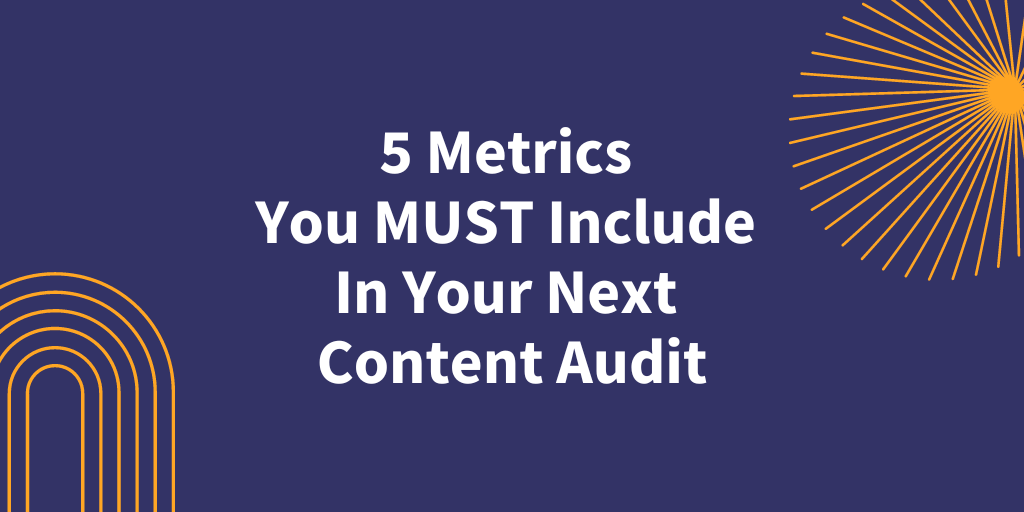
Do you know how well your content is helping you achieve your business goals?
Most businesses focus on creating content, which can be time-consuming and stressful all on its own.
But if you don’t know what’s working and what needs improving, you risk putting your effort into content that isn’t making a positive impact.
That’s why regular reporting and content audits should be a cornerstone of your content marketing process!
What’s a Content Audit?
A content audit systematically analyzes and reviews a portion of your content marketing strategy. For this post, we’re going to focus on website content audits, which include:
- Reviewing all landing pages
- Blog posts
- Educational and/or lead-generating content
The goal is to identify weaknesses in your content strategy and workflow, and adapting them to changing market and business goals.
What’s Does a Content Audit Do?
Content audits help you decide which aspects of your website are working and which aren’t based on your goals and key performance indicators (KPIs).
Content audits are how you identify underperforming website content that needs to be fixed, updated, or avoided in the future. Some examples include:
- Outdated information that should be removed or updated
- Links that don’t work
- Errors, typos, and other grammatical issues
- Missing words or metatags that can impact your SEO rank
- Content gaps you can fill with more content
How to Do a Content Audit: Getting Organized
Before we jump into the metrics you should cover, let’s review what you need to do to prepare to do a content audit:
Define Your Goals and Metrics
Content audits take time, so you’ll want to start with well-defined objectives. Some examples include:
- Learning which pages rank highest for SEO
- Identify old content that should be removed
- Optimize your internal linking
- Increasing audience engagement
- Find out which pages are converting the highest
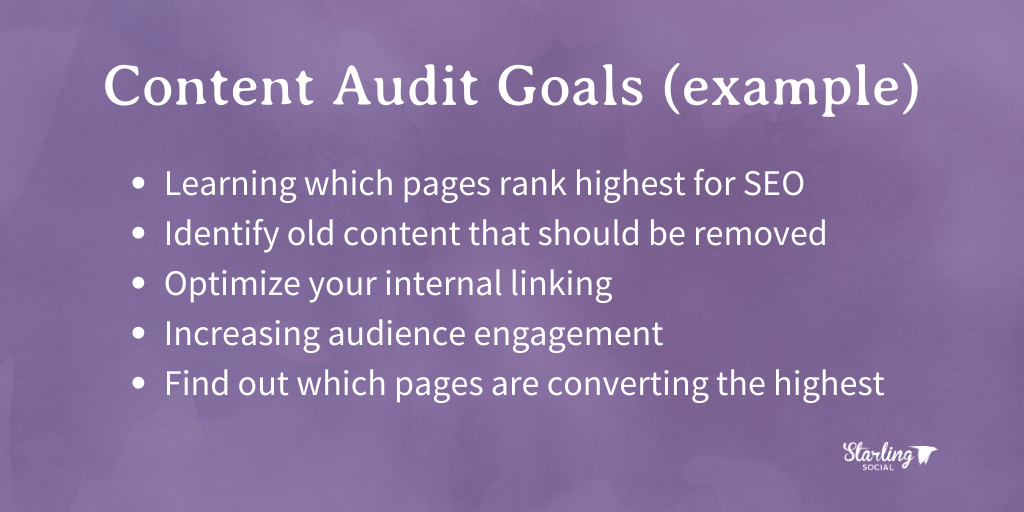
Decide What Content You’ll Review
Most website content audits include a review of landing pages, blog posts, product descriptions, educational material, and product descriptions.
If you have, you can also assess other types of content like embedded videos, PDFs and other gated content, and interactive content like tests, quizzes, and games.
This process can be time-consuming, so we recommend using a tool like SEMRush Content Audit or Screaming Frog (which we use here at Starling) to gather your URLs in one place.
Now that you’ve gathered your data, it’s time to look at the top five metrics you want to pay the most attention to:
The 5 Most Important Content Audit Metrics
1. Page Load Time
Search engines use page speed as one of their top ranking metrics because a fast site provides a better user experience. If your page loads quickly, that page is more likely to earn a higher spot on a Search Engine Results Page (SERP).
A quickly-loading page helps with SERP rankings and provides a better user experience. A mere one-second delay in page loading makes page views drop by 11% and causes customer satisfaction to drop by 16%.
If you aren’t using a 3rd party tool, we suggest using Google’s speed checker from their Google Developers toolkit to assess page speeds manually.
Note: you can currently also do this in Google Analytics by navigating to behavior> site speed > page timings, but with the new G4 rollout coming in July of 2023, we’re trying to avoid advocating for specific steps behind-the-scenes too much right now.
2. Readability
73% of adult Americans read at only a basic or intermediate level, so we need to aim for an 8th-grade reading level whenever possible.
Not only does writing simply help people understand your site’s content, but Google’s web crawlers don’t struggle to understand the text’s meaning and links.
If the meaning is unclear, your page won’t rank well. If your audience doesn’t understand, they’ll click away. Both of these actions increase your bounce rate and hurt your SEO.
The Hemingway editor is our favourite tool for keeping our writing clear and concise. It helps us keep our sentences short and to the point.
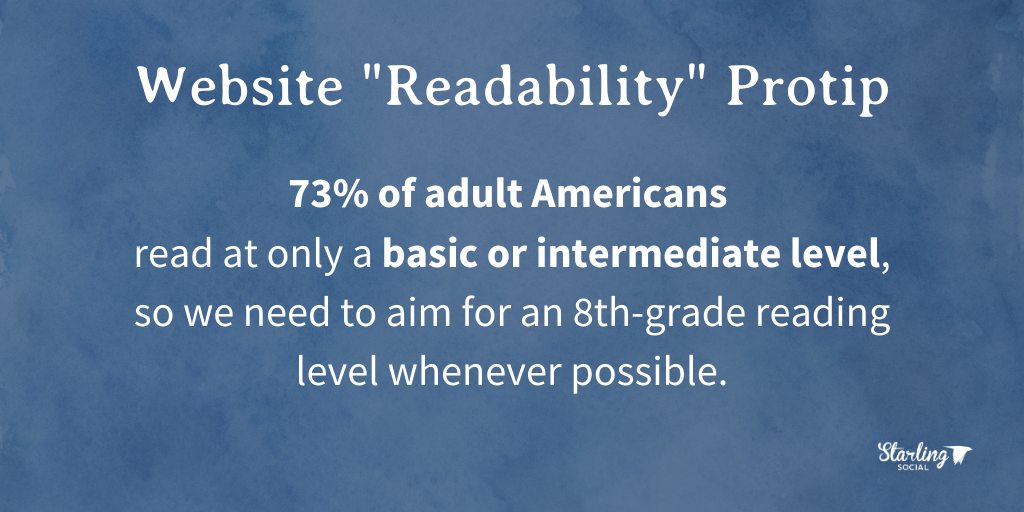
3. Backlinks
A “backlink” is when another site links to yours. Search engines like Google see a backlink as one website saying to another: “I find this content valuable, so I’m going to link to it.”
You’ll need to use a 3rd party tool like Screaming Frog, Moz, Semrush, or Ahrefs for this part.
You can also “boost” underperforming content by linking to it from other pages on your site, known as “internal linking.” This helps users discover pages that they may not have otherwise.
4. Bounce Rate
A “bounce” happens when someone arrives on a page and then leaves without doing anything (clicking a button, navigating to another page, etc.)
If you have a high bounce rate, it could be a sign that the content isn’t serving its intended goal.
Ideally, your content acts as a gateway that leads users from a search to your site, informs or entertains them, and encourages them to consume more content or convert.
When someone spends a lot of time on a page, it’s called “sticky” content that keeps users interested enough to explore the rest of your site.
What’s a good bounce rate? Generally speaking, depending on your industry, 26% to 40% is good.
5. Organic Traffic
Ideally, most of your traffic should come from “organic” (unpaid) sources, like people searching on sites like Google and through backlinks to other websites.
If you’re not getting a lot of organic traffic, that could mean that there’s an issue with the following:
- Your content strategy
- How you’re sharing your content
- The content topic
- What you’re writing/the content itself
Bonus: Other Content Audit Metrics to Look For
We’ve just listed a handful of important metrics to pay attention to, but there are several others to look for, including:
- Time on Page. This metric tells you whether the content you’re publishing is suitable for your audience. If this metric is high, then that’s a sign to publish more content like it.
- Unique Visitors. The more unique people visit your site, the higher the likelihood that some of those people will engage with your content, link back to it, or convert.
- Pages Per Session. Measures how many pages someone looks at after they’ve finished looking at the content on the first page they see.
- Traffic Sources. Where are your visitors coming from? Look for social media sources, emails, other websites, and organic searches.
- New vs. Returning Users. Returning users are great, but we need to keep attracting new people to our site to gain new customers.
- Conversions. We didn’t include this in the top 5 because not every piece of content is intended to convert. Many exist just to educate, inform, or inspire), but make sure to pay attention to your website conversions and their sources (a landing page, email newsletter, etc.), so you can create more content to encourage that action.
Start Publishing Better Content Today
Doing a content audit gives you valuable insight and data that you can use to know if your content marketing plan is moving in the right direction or if you need to pivot somewhere.
When you see content doing well, note its details, including the topic, when it was published, and if it was timely or evergreen.
Then, work to repeat your success based on what you’ve learned.
For content that’s underperforming, take note of those metrics and work to avoid them in the future.
If you’re looking for help writing content for your website, blogs, and email newsletters, drop us a line! We’re an agency founded on rhetoric and +22 years’ experience publishing content online, and we’d love to help.
10 Ways Your Business Can Celebrate International Women's Day in 2023
- by Alyson Shane
International Women's Day has a rich history dating back to the early 1900s, when women worldwide began organizing and advocating for their rights. It was officially recognized by the United Nations in 1975, and it has since become an annual event celebrated by people of all genders in countries around the world.
If you’re wondering how your business can honour women's social, economic, cultural, and political achievements, use our blog for inspiration on ways to celebrate at work.
What is International Women’s Day?
International Women’s Day has been celebrated for over 100 years, and it has become an important annual event for people of all genders to come together and support gender equality. The event takes place annually on March 8th to celebrate the achievements and progress made by women worldwide, and to raise awareness about the challenges and issues women face.
One of the most important ways to celebrate International Women's Day is to educate yourself and others about the history and significance of the holiday.
#EmbraceEquity
The 2023 campaign theme for IWD is Embrace Equity. The day is a reminder to seek diversity, inclusion and equity by calling out and challenging stereotypes and gender discrimination. Collective activism is what drives change.
You can actively support and embrace equity within your own sphere of influence. InternationalWomansDay.com is asking people to strike the #EmbraceEquity pose this year and share on your social channels and use #IWD2023 and #EmbraceEquity to encourage others to do the same.
Ways to Celebrate International Women’s Day
There is no one right way to celebrate. All efforts advancing women's equality are welcome and should be respected.
Donate to a cause that supports women and girls
This could be a local shelter for women and children, a global organization working to promote women's rights or a campaign to raise awareness about a specific issue affecting women.
The charities of choice from the IWD website are:
- World Association of Girl Guides & Girl Scouts
- Catalyst
- Equality Now
- Nomi Network
- Dress for Success
- Womankind Worldwide
Look for an organization that aligns with your values and consider making a donation to support their work.
Host an event or activity
Hosting an event can be as big or small as you like. Collective action is all that’s needed. The International Women’s Day site has a list of activities as inspiration:
- Holding an event (digital or hybrid)
- Launching a project or initiative
- Delivering female-focused activity
- Activating a marketing campaign
- Developing resources
- Conducting research
- Running a social media campaign
- Making a video
- Speaking at a local school
- Collaborating with the media
Think about what would be most impactful at your workplace!
Attend an International Women's Day event or rally
You can find International Women’s Day marches, talks, and workshops in many cities and communities worldwide. These are great opportunities to learn more about the issues facing women and girls and show your support for gender equality.
You can search for International Women’s Day events here.
Share your appreciation for the women in your life
Whether it's sending a message of thanks to a colleague or friend, or simply telling the women in your life how much they mean to you, expressing your gratitude is a meaningful way to celebrate International Women's Day.
Support women-owned businesses
On International Women's Day and every day, consider supporting women-owned businesses. This could be anything from a small boutique to a large corporation, and it's a great way to show your support for women in the business world.
If you are local to Manitoba, the Women’s Enterprise Centre has a directory of women-owned businesses that you can find here.
Volunteer your time
Many organizations that support women and girls rely on volunteers to help them achieve their goals. Consider offering your time and skills to help out with a cause that's important to you.
Wear purple, green or white
These are the official colours of International Women's Day, and wearing them on the holiday is a simple way to show your support for women's rights.
Purple signifies justice and dignity, green symbolizes hope, and white represents purity.
Start a conversation
Use International Women's Day as an opportunity to start a conversation about gender equality and women's rights. Talk to your friends, family, and colleagues about the issues that matter to you and listen to their perspectives.
Take action
International Women's Day is a day of action, so consider what you can do to make a difference in the lives of women and girls. This could be anything from advocating for a policy change to organizing a fundraiser to supporting a campaign.
Share your example
An easy way to share is by posting on your social media pages. If you aren’t sure what to post, you can download IWD2023 social media templates here. Or use your platforms to share positive and inspiring messages about women and gender equality. Make sure to use #IWD2023 #EmbraceEquity.
No matter how you choose to celebrate International Women's Day, the most important thing is to recognize and appreciate the contributions of women everywhere. Whether you take part in a large event or simply show your support in your own way, every little bit helps to create a more equal and fair world for women and girls.
For more information and resources on International Women’s Day, visit their website here.
50+ Valentine's Day Subject Lines for E-commerce Sales
- by Alyson Shane
Love is in the air, and Valentine's Day 2023 is just around the corner!
Valentine's Day is a huge day for online retailers, which means you've probably been thinking about how to make the most of the day — but have you considered how the lingering effects of the pandemic have changed consumer behaviour?
Statista said Valentine's Day 2022 saw $23.9B spent on gifts for partners, friends, pets and more. Spending is down from $27.4 billion in 2020, but while spending might be down compared to previous years, E-commerce spending is up.
Before the pandemic, people tended to spend money on dates and tactile experiences, but the trend toward online shopping is expected to increase.
This means email marketing is more important than ever, which is why we've put together this roundup of some of the best, most clickable email subject lines to promote your products this season:
5 Subject Line Best Practices
Before we dive into V-Day specific subject lines, let’s take a second to review what makes a subject line worth clicking on in the first place:
1. Make it personalized. One way to personalize your emails is to list the "from" field as coming from a person at your company instead of the company name. This helps humanize your brand.
You can also personalize your emails based on information about the subscriber. For example, if they've added an item to their cart but not checked out, you can email them a discount if they check out now.
2. Use numbers. A study from Yesware that analyzed over 115 million subject lines sound that including numbers in subject lines can increase both open rates and reply rates:
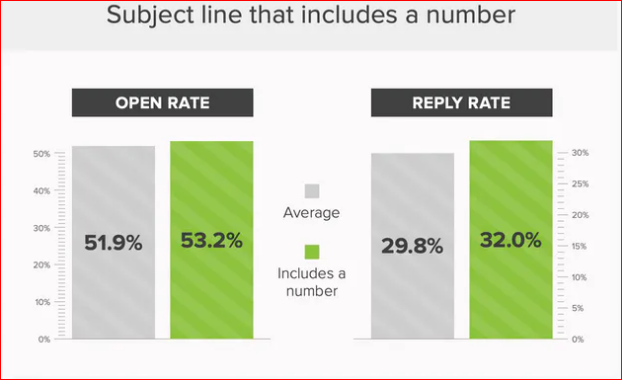
3. Keep it short. Almost 50% of people prefer to check their emails on their phones, so a lengthy subject line will get cut off after 43 characters.
A study from Marketo found that subject lines with just four words earned the highest open rates (18.26%), but the click-to-open rate (or CTO, which measures how many people opened and clicked on an email) happened with seven-word subject lines (10.8%), followed by nine words (10.6%) and six words (10.1%).
4. Use your preview text/preheader text strategically. While subject lines should be short, you can amplify your message using this email section. Here's an example we love from Derek Halpern, that asks a question that entices people to open his email:
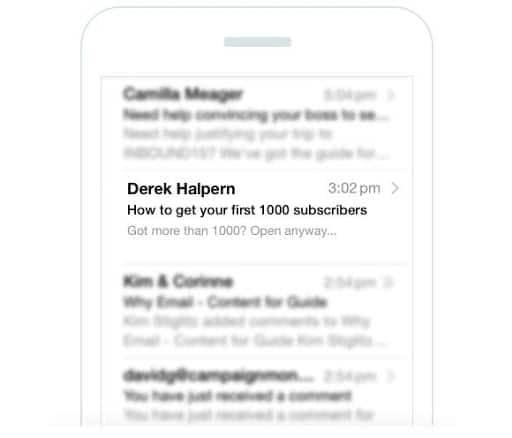
5. Use power words. “Power words” are exactly what they sound like — they’re words that trigger an emotional response in the person reading them. We’ve included lots of them in the subject lines below, but here’s a list of 801+ power words via SmartBlogger for you to use.
Bonus: Use emojis (sparingly). Emojis are an easy way to help your subject line pop in a subscriber’s inbox. Just make sure to follow these two rules:
- Only use one emoji per email. More than one could trigger spam filters.
- Don’t use emojis in place of words. Some email providers don’t display emojis, which could harm your messaging.
Generic Valentine’s Day Email Subject Lines
Sometimes, simple is best. We love these subject lines because they play into themes like love, being creative with gift-giving, and highlighting special offers like buy one, get one free (BOGO).
- The best Valentine’s savings are here!
- Save 15% on all Valentine’s Gifts
- Will you be our Valentine?
- Don’t miss these Valentine’s Day deals!
- Up to 80% off Valentine’s gifts!
- Gifts your sweetheart will love
- Be mine! Our Valentine’s Day gift guide is here
- Your Valentine's Day gift is inside
- These Valentine’s Day gifts are better than roses
- Treat your sweetheart (and yourself)
- 1 for you, 1 for your Valentine
- Don’t miss these sweet Valentine’s Day savings!
- A special Valentine's treat for you
- I choo-choo-choose you - Valentine’s Day sale
- Spoil your sweetheart with our Valentine’s gift guide
- Gifts that’ll make them fall in love over again
- Feel the love this Valentine’s
- Valentine’s Day gifts they’ll love
- Treat yo’self this Valentine’s Day
- A sweetheart deal for you!
- Don’t miss these sweet savings
- Happy Galentine’s Day!
- Treat your best gals this Galentine’s Day
Valentine’s Day Email Subject Lines That Mention Shipping
Mentioning shipping dates and deadlines in your email subject line is a great way to create a sense of urgency and encourage subscribers to open your email immediately.
Protip: offering free shipping in the subject line is a great way to grab people’s attention and get them to buy from you while they’re ankle to take advantage of the discount.
- Only 14 days left for FREE Valentine’s shipping
- Free shipping until February 14
- Final day to order for Valentine’s Day
- Order now for delivery by February 14!
- Last chance for FREE delivery by Valentine’s Day
- Save this Valentine’s with free shipping
- Our Valentine’s gift to you: free shipping!
- Ship more, save more this Valentine’s Day
- Last chance to get FREE Valentine’s Day shipping
- The perfect Valentine’s gift: free shipping!
- Last chance to get your gifts before Valentine’s Day
- Order NOW to get your Valentine’s Day gift on time
- Guaranteed delivery for Valentine’s Day
- LAST CHANCE: save on Valentine’s Day shipping
- LAST CHANCE to get your Valentine’s gifts on time
- Better than roses: FREE Valentine’s Day shipping
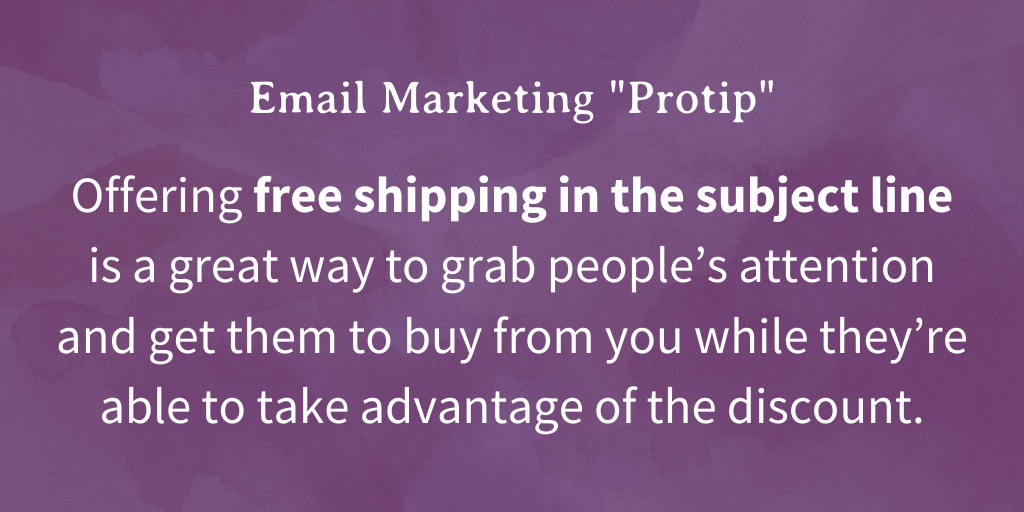
Valentine’s Day Email Subject Lines With Emojis
Like we said earlier: emojis are a great way to stand out in subscriber’s inboxes. They also “break up” the subject line and pre-text/preheader which makes them both easier to read. Win-win!
Protip: the examples we’re using are generic ones to get you inspired, but the more unusual the emoji you use, the higher the likelihood that people will open your email.
- Happy Valentine’s Day ?
- Cupid’s calling — it’s almost Valentine’s Day ?
- Valentine’s Day gifts your sweetheart will love ?
- Sweets for your sweetheart ?
- Sparkling savings this Valentine’s Day ?
- Buy one, get one free this Valentine’s Day ❤️
- Celebrate Valentine’s Day in style ?
- Find the perfect Valentine’s Day gift inside ?
- Valentine’s Day gifts for your sweetheart ?
- Show how much you care this Valentine’s Day ?
- 10 last-minute Valentine’s Day deals ⏰
- Don’t miss these Valentine’s Day savings ?
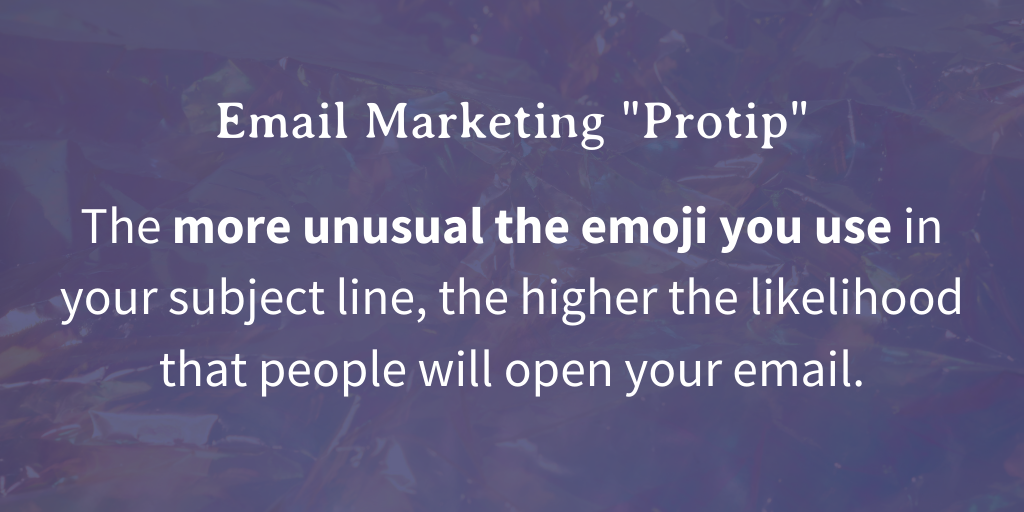
Spread the Love This Valentine’s Day
As you can see, when it comes to Valentine's Day email subject lines, the sky’s the limit! Adding a fun, holiday-themed twist to your email marketing is easy, especially when you use the post above as a reference.
Looking for more timely tips on creating effective marketing campaigns? Subscribe to our weekly roundup of the hottest digital marketing news and strategies! Click here to get in on next week’s send.
7 Hot Email Marketing Trends for 2023
- by Alyson Shane
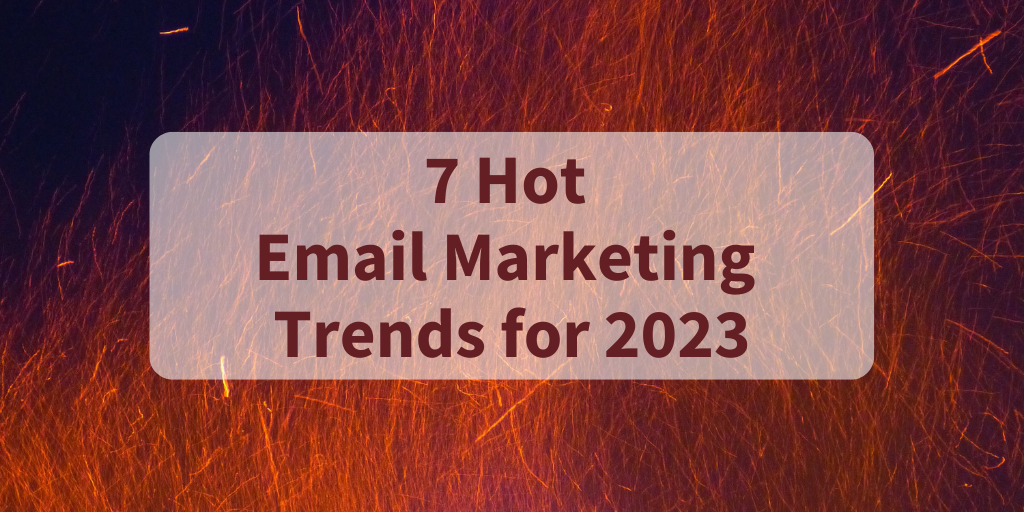
If you want to make meaningful connections with your customers, help them find out about your products and services and regularly grab their attention, email is a must-have in your marketing strategy for 2023.
89% of marketers state that email marketing is their primary strategy, and the global email marketing market is projected to increase to $17.9 billion by 2027.
This means there’s no better time to invest in this effective, scalable, and cost-effective way of reaching your customers!
But email marketing (like any marketing) can only be successful if you pay attention to the latest trends and adapt accordingly.
That’s why we’ve put together this list of email marketing trends you need to know for 2023 — let’s dive in:
Trend 1: A Focus on Privacy
In 2018 the General Data Protection Regulation (GDPR) legislation redefined the world of email marketing. It made the practice of cold emailing and email list building illegal, and forced businesses to rethink how they gather data.
Before the GDPR passed, you could legally buy “lists” of emails and blast out emails to anyone on that list. Those around in the 90s and early 2000s might remember the wave of spam that regularly flooded our Yahoo and Hotmail inboxes — this was because rules like the GDPR didn’t exist.
Since then, consumer expectations about how, when, and why a brand can email them have pivoted to an increased focus on privacy.
In a world where customers are increasingly sensitive to how often they hear from brands they follow, our favourite tactic is to ask leads to fill out a short questionnaire about how often they want to hear from our clients.
You can put this questionnaire on a landing page, but we prefer adding it to a “welcome” email since people are less likely to fill out lengthy forms.
This has the added effect of:
- Adding more segments to your subscriber database
- A better understanding of your subscriber’s wants
- Helping subscribers get what they expect
Trend 2: Opening Rates Aren’t the Main KPI
Apple’s release of iOS 15, iPadOS 15, macOS Monterey, and watchOS 8 has a new feature to protect users’ data from 3rd party apps. From Apple:
“In the Mail app, Mail Privacy Protection (MPP) stops senders from using invisible pixels to collect information about the user. The new feature helps users prevent senders from knowing when they open an email, and masks their IP address so it can’t be linked to other online activity or used to determine their location.”
Email tools use pixels that “fire” when someone opens their email, which calculates the open rate of any email you send. But now, Apple preloads all email content which means the pixel never fires and the email appears “opened” even if the recipient never looks at it.
This means marketers have less reliable data about things like:
- When users open emails
- Where users open emails
- The device users are using to open emails
- The activity on the device used to open the email
Now, if a recipient is on an Android device or a PC, this doesn’t necessarily apply, but with 49% of all smartphone users in the U.S. alone using Apple devices, it’s safe to say that if you need to take your open rates with a grain of salt in 2023.
Instead of focusing on open rates as the leading key performance indicator (KPI), we suggest looking at data like:
- Click-through rate. How many people clicked one or more links in your email.
- Conversion rate. How many people clicked through and took an action like completing a purchase or filling out a form.
- Bounce rate. The percentage of emails you sent that couldn’t be delivered to an inbox.
- List growth rate. The rate at which your email list is growing.
Trend 3: Hyper-Personalization
33.2 billion emails were sent in 2022, meaning brands compete for more attention in subscribers’ inboxes than ever before. In response, more companies are using personalization to grab subscribers’ attention.
Personalization is an email marketing trend that can have a variety of positive effects, including:
- Improving open rates by 42%
- Increasing the average click-through rate (CTR) by 14%
- Increasing conversions by 10%
- Personalized subject lines can improve open rates by 26%
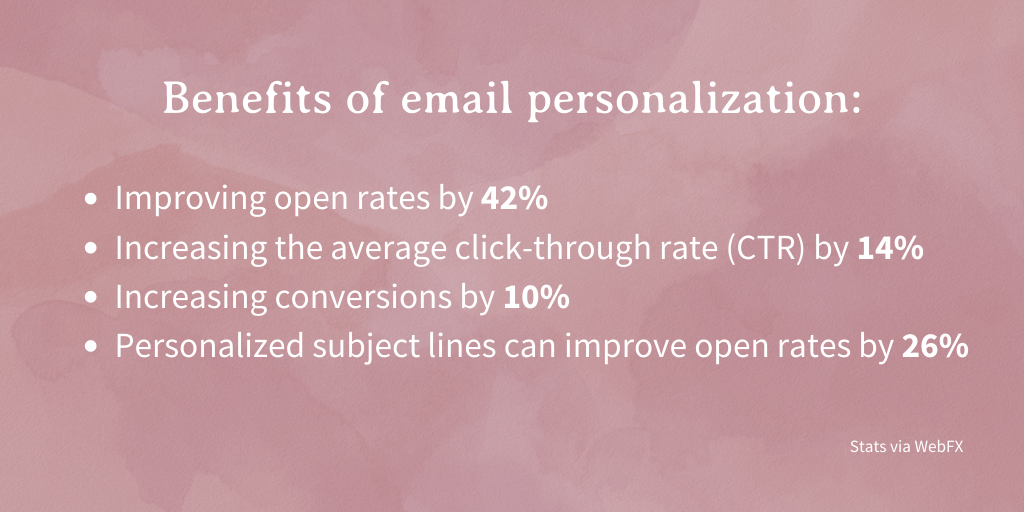
What happens if you don’t lean into personalization? Here are some actions customers have reported taking after receiving a non-personalized or mistargeted email:
- 68% of people automatically delete emails
- 54% unsubscribe
- 45% categorize them as junk or spam
- 29% become less willing to buy products
- 13% visit the website less frequently
- 10% never visit the website again (yikes!)
Stats aside, this trend has been on the rise for years and is expected to continue, so here are a few actions you can take to keep subscribers engaged with your emails:
- Segment your audiences and tailor promos and messaging to those segments
- Recommend specific products based on audience segment
- Send “trigger” emails based on subscriber behaviour
- Recommend products or content based on individual subscriber behaviour
Trend 4: Focusing on Mobile
81% of emails are opened on mobile devices nowadays, and people use their phones to sort through the emails they receive and decide what’s worth opening and what isn’t.
With this in mind, it’s essential to make sure that your emails are formatted to look good on smaller screens by taking actions like:
- Ensuring your designs are mobile responsive
- Write short, snappy emails that get right to the point
- Include big buttons and clear calls-to-action (CTAs)
Keeping your emails free of clutter and being sensitive to how much copy you put in your emails can go a long way to increasing your click-through rate and conversions.
Trend 5: Email Marketing Automation
Email marketing automation allows you to pre-design how and when a subscriber hears from you because the emails they receive are predetermined based on specific actions they’ve taken.
Also known as “drip campaigns,” this type of email marketing performs better than regular email campaigns because the interactions feel personalized and friendlier.
As a result, this type of email campaign can generate 320% more revenue than non-automated emails.
Some ways you can automate your emails are:
- Using email templates and “drip” campaigns available through your email marketing tool.
- Automate list “scrubbing,” which is the process of comparing two (or more) email lists to look for data that doesn’t match, is incomplete, or is duplicated.
- Sending automated transactional emails to customers
- Automating your onboarding process with a “drip” campaign
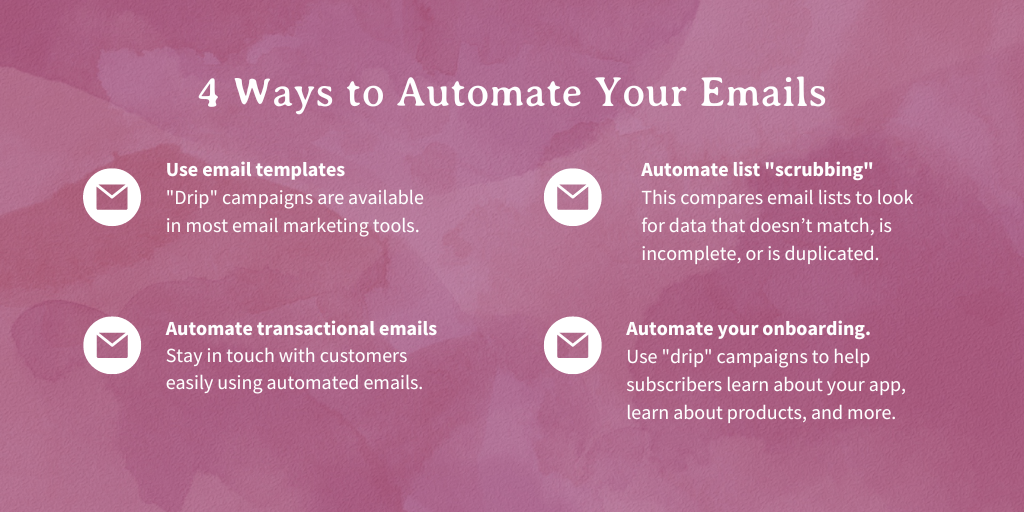
Trend 6: Interactive Emails
Interactive emails are (you guessed it) emails that include elements that boost customer engagement and keep them interested in the content of your email.
These are perfect for eCommerce businesses because they allow you to create eye-catching, engaging emails that keep customers interacting with your content (and increasing the likelihood that they’ll buy).
Some examples include:
- Rollover effects to showcase a handful of products
- Animated buttons and calls-to-action (CTAs)
- Interactive image and product carousels users can click through
- “Accordion” features that make long-form emails more compact
- Surveys, pills, and other interactive content
Note: since some of these require changes to the Javascript code behind your email, you’ll want to either have an in-house IT person help put these together or use a tool like Klayvio or Freshinbox that can help you do it yourself.
Trend 7: Rethinking Your Email Design
We’ve talked a lot about emerging trends, but the hottest trend in email marketing right now is reconsidering how your emails are designed from the bottom up.
With this in mind, here are a few design trends to consider:
- Dark mode. Apple first introduced “dark mode” in 2018 to help users look at their screens without adjusting the brightness. Consider integrating “dark mode” options into your email to make your email appearance consistent with the rest of the user experience.
- Dynamic gifs and animated collaging. Using moderate animation is a hot trend expected to continue into 2023 — just make sure you’re smart with how you use them!
- Focus on minimalism. As we said above, people want to read short, snappy emails, so make sure your emails are uncluttered and focus on a single topic or “ask” per email.
Stay Up-to-Date With Email Trends in 2023
2023 will be a year filled with challenges and opportunities for brands to shine in subscribers’ inboxes. By following the trends outlined above, you can make sure your emails are opened, engaged with, and lead to conversions that help grow your business.
For all the latest email marketing trends throughout the year, subscribe to our weekly digital marketing newsletter.
Digital Marketing New Year's Resolutions for 2023
- by Alyson Shane
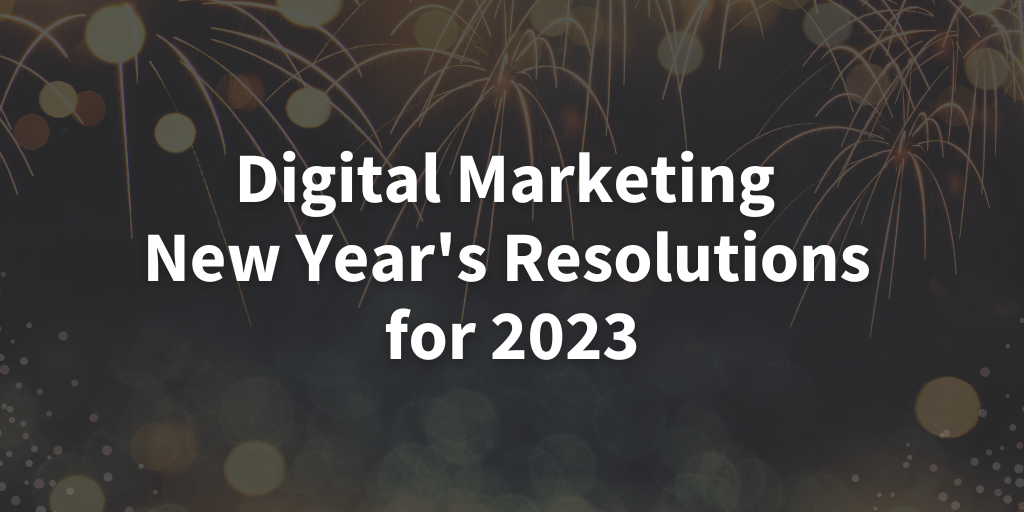
It’s almost that time of year again! As we say “bye” to 2022 and “hi” to 2023, it’s the perfect time to reflect on our business practices and think about ways to make positive changes for the coming year.
While they might seem campy, New Year's resolutions are a great way to reflect on the year that’s passed and plan to make positive changes in the coming 365 days.
Even though most people make New Year’s resolutions, only about 12% achieve them. Why? Because most people aren’t specific enough, or they don’t know how to track their progress or a variety of other reasons.
As the leader of a team invested in helping your business thrive online, I’ve put together a list of achievable digital marketing New Year resolutions based on the latest best practices for 2023.
What is a Digital Marketing Best Practice?
The reality is that there’s no “right” way to do digital marketing, but by leaning on the experts and looking at the data, we can create recipes for success.
I lean on data and sources when developing a strategy for our clients. I use Feedly to keep tabs on the latest news and catch up daily on the latest trends and developments.
(If this sounds like too much work, I feel you. That’s why I started our weekly newsletter that you can subscribe to for all the top tips and updates in digital marketing!)
Best practices are how we make smart, informed decisions about our digital marketing, which is why all of the New Years’ resolutions listed below fall back on a foundation of data.
Ready to level up your online presence in 2023? Then take these resolutions to heart:
Develop Audience Personas
When I talk about a “persona,” I like to describe them as “fake versions of real people” because that’s what they are.
Sure, you might know who your customers are in your head, but taking the time to document and understand them can lead to a 73% increase in all opportunities from online marketing!
Personas help us understand the specific needs that your customers or clients may have on a granular basis and vary depending on whether you have a B2B (business-to-business) or B2C (business-to-consumer) business.
For example, if you run a B2B business, you may want to consider things like:
- What’s their role in the company?
- What kind of buying power do they have?
- How much can they spend?
- What do they care about? (How can we make them look good?)
- Do they need approval for extra spending?
- If yes, who are the other key stakeholders?
- Who are the other key stakeholders (they all need personas, too!)
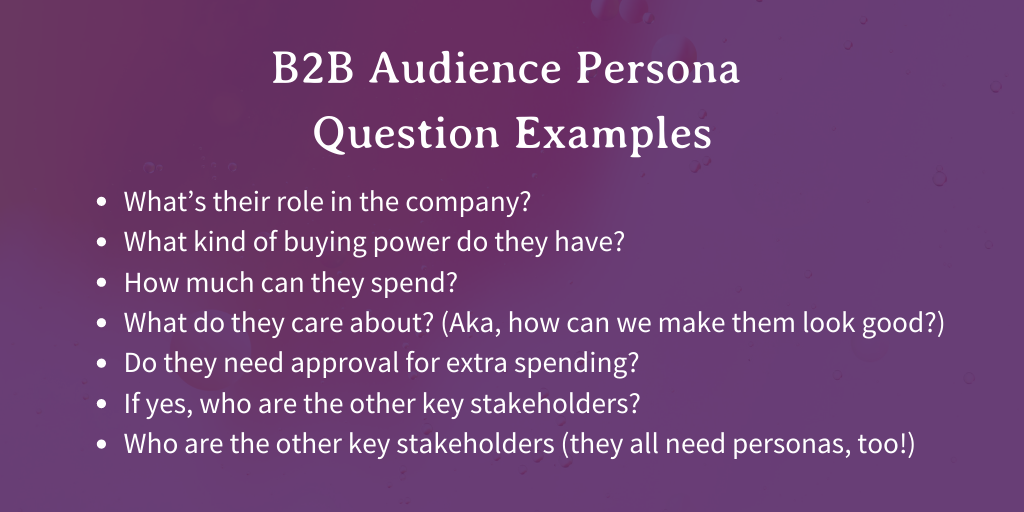
If you run a B2C company, you might want to consider things like:
- Their age, gender, and demographics?
- Their relationship status?
- Their annual income (if possible)?
- How much do they spend at once?
- Are they a repeat buyer? If so, when?
- Are they an impulse buyer, or do they wait for a sale?
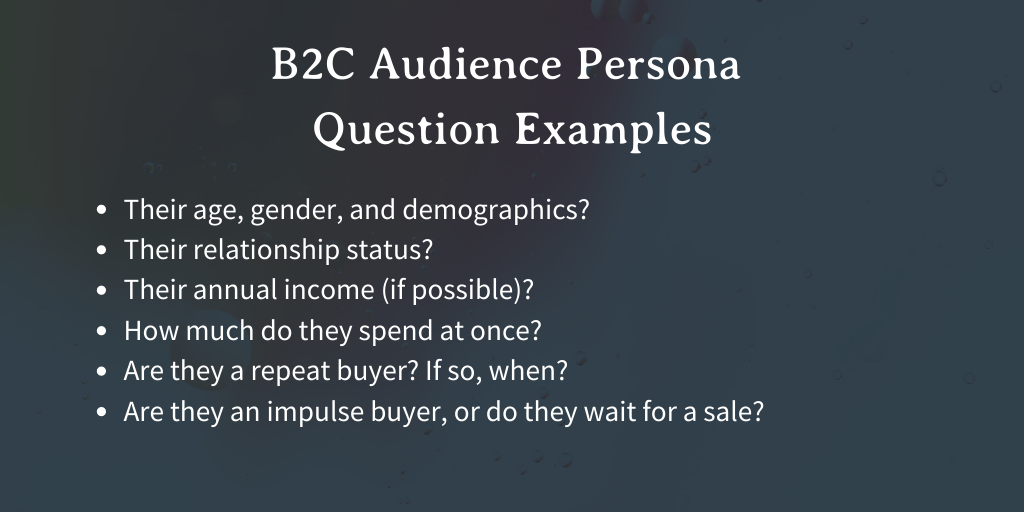
As you can see, personas can get pretty in-depth, which is good! The more you know about your customers and the people involved with how, when, and what they buy, the easier it is to write marketing copy that speaks to their needs.
Reintroduce Your Brand
People want to spend money on things that make them feel good, and one way you can encourage them to buy from you is by using your story in your digital marketing.
This isn’t about tricking people into buying from you! This is about telling a story in a non-salesy way about your brand, how it got started, and what motivates you to keep doing what you do every day.
If people love a brand story, 55% are more likely to buy the product in future, 44% will share the story, and 15% will buy the product immediately.
Talking candidly about how your company got started is a way to create empathy and put a “human” face on your brand, which helps prospective customers and clients empathize with you.
Business is about forming relationships with people. Humans are emotional creatures, and creating a solid emotional connection by being candid and vulnerable will encourage people to support your business.
Be Platform-Specific in Your Content
Maybe the tl;dr version of this could be: stop cross-posting from other social media sources!
Every social media platform is unique. From the image ratios to where the text in a post gets cut off, it’s essential to understand the differences between the platforms and adjust your copy accordingly.
For example, Facebook and Instagram truncate (aka, cut the text off with “...”) after 125 characters, but LinkedIn truncates it after 140 characters.
This means you have a little more space to showcase your core messaging on LinkedIn, so don’t copy/paste the same content to all three.
People also have expectations about the type of content they see on social networks. LinkedIn, for example, is a more business-focused platform, so gifs and terms like GOAT might not resonate with people there as much as they would on a more laid-back platform like Twitter.
Upload More Videos
Confession time: I hated shooting Reels when they started becoming popular.
I’m a writer by trade, and I prefer to do exactly what I’m doing: sit behind a desk with a coffee typing out my thoughts… but that’s not how social media works anymore.
The average user attention span in 2022 was just 8 seconds, and video is the easiest way to stop someone mid-scroll. 80% of consumers want to see more videos from businesses.
Since TikTok exploded onto the scene, it’s time to start getting comfortable in front of the camera and posting video content to all your social platforms.
If you’re feeling overwhelmed with the thought of getting into video (I get it), here are a few things to keep in mind:
- “Raw” videos do best. People like videos that are less edited and feel natural.
- Shorter videos do best. As I said, people’s attention spans are short, so play to this!
- Don’t be afraid to be goofy or silly. The fastest way to make a boring video is to take it too seriously, so have fun with it.
- Don’t overthink it. Really! Content moves fast on the internet, so nobody will penalize you even if you make a less-than-stellar video.
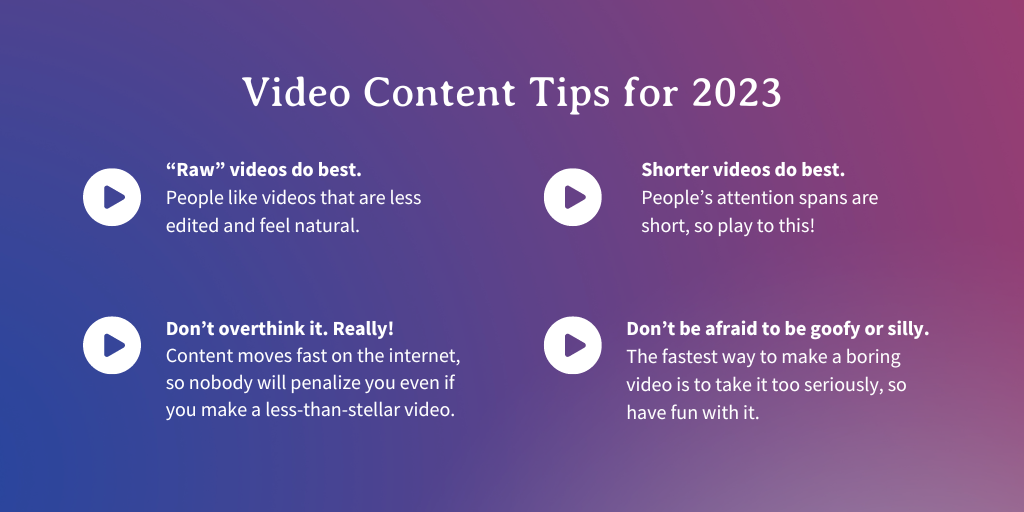
Do a Digital Marketing Audit
It’s never a wrong time to take a critical look at your online presence, and the start of the year offers the perfect opportunity to recognize where you’re doing great and where you could step things up.
How deep your digital marketing audit goes depends on a lot of factors, but here are some things to consider:
- Your audience personas and where they spend time
- The type of content you share on social media
- The strategies you use to publish that content
- Your page growth and outbound engagement strategies
- Your content strategy (blogs, newsletters, etc.)
If you’re unsure where to start, I specialize in digital marketing audits, so feel free to give me a shout, and we can get started!
Review Your Hashtag Strategy
Hashtag strategies change depending on the social network you’re posting to, so it’s essential to review your hashtag strategy and adjust it regularly.
For example, even though technically Instagram allows up to 30 hashtags, the latest research finds that the optimal number of hashtags is between 3 — 5 per post.
For Twitter, the platform suggests sticking to 1-2 targeted hashtags and actively discourages using brand slogans as hashtags.
Another hashtag best practice is only to use hashtags that relate to the content in your post. For example, don’t post about your brand new campaign and use the #ootd (Outfit of The Day) just because it’s a popular hashtag.
At Starling Social, we use a “blended” hashtag strategy. Not sure what that is? Drop us a line, and we can chat about the best hashtag strategy for your brand.
Document Your Digital Marketing Strategy
I firmly believe that documenting our thoughts is how we maintain clarity and consistency in our actions.
Documentation that explains our thinking and process and helps keep everyone on the same page.
It’s also a “power move” if you’re a 100% remote agency like we are at Starling Social since everyone on our team and our client’s teams can access important information.
From a business perspective, effective documentation can give you a leg-up on the competition since only 48% of smaller organizations and 41% of larger companies document their strategies.
Invest in Digital Ads
Getting eyeballs on your website and organic (unpaid) social media posts is more challenging than ever, which makes 2023 the ideal time to start investing in ads to help more clients and customers find your brand.
When it comes to digital ads, there are two “high-level” options to choose from:
Pay-Per-Click (PPC) Advertising
Pay-per-click ads are shown on search engine results pages (SERPs) on sites like Google and Bing.
These ads effectively reach consumers at the bottom of the sales funnel because they’re actively searching for the item or service you offer.
This makes it easier to convert them (aka, get them to buy) because the fact that they’re searching for it shows intent to buy.
Another aspect of PPC advertising is retargeting. Once someone has taken an action on your site like clicking a link or adding something to their cart, you can remind them about that item by showing them retargeting ads on other places around the internet.
Almost 70% of customers “abandon” the items in their carts, but retargeting ads can bring back 26% of those shoppers and get them to complete their purchase.
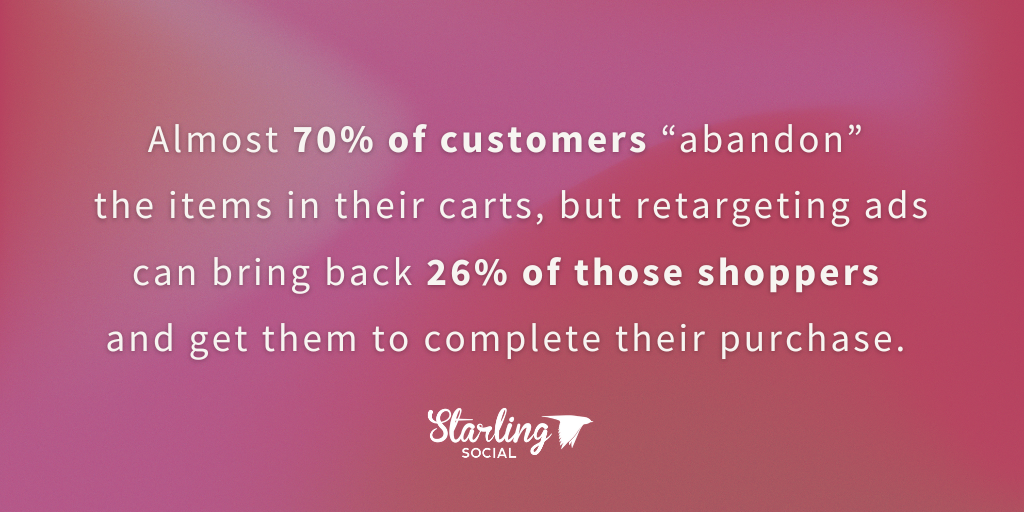
Social Media Ads
Social media ads are a great way of generating brand awareness! Half of adult internet users say that when brands use their data in advertising, it helps them discover (50%) and find (49%) products and services that interest them.
Not only are social media ads effective at helping introduce (or reintroduce) consumers to your brand, but you can also run retargeting campaigns on social media platforms where your audience is most active.
Lean Into Email Marketing
I like to say that “getting someone’s email is like getting the spare key to their house” because it allows your brand to connect with people in the most private place online: their inbox.
I’ve been talking about social media trends and how to stand out in increasingly crowded digital spaces, but email offers a great way to help potential customers see your content.
Part of what makes email marketing so successful is how connected we are to our inboxes. For example, 58% of us check our first thing in the morning!
Whether you’re a B2B or a B2C business, connecting with your audience through their inbox can increase conversions by up to 3x compared to social media marketing.
Cart abandon emails are your besties if you’re a B2C company. More than 40% of all “cart abandon” emails get opened, and out of those opened, 21% of them received click-throughs.
For B2B businesses, newsletters are a great way to keep your audience in the know. If you’re unsure how to write ’em, check out this post!
Make Your New Years’ Resolutions Today
Setting goals for yourself is how you can build and grow your online presence in 2023. Review the points I’ve listed above, sit back, and ask yourself, “what else can I commit to doing so more of my ideal customers find my business?”
A new year is the perfect time to take an objective look at your digital marketing and make strategic, data-driven decisions to help you increase your bottom line in the coming year. If you’re not sure where to start, drop us a line! I’m always happy to chat.
7 Holiday Marketing Campaigns For the 2022 Season
- by Alyson Shane
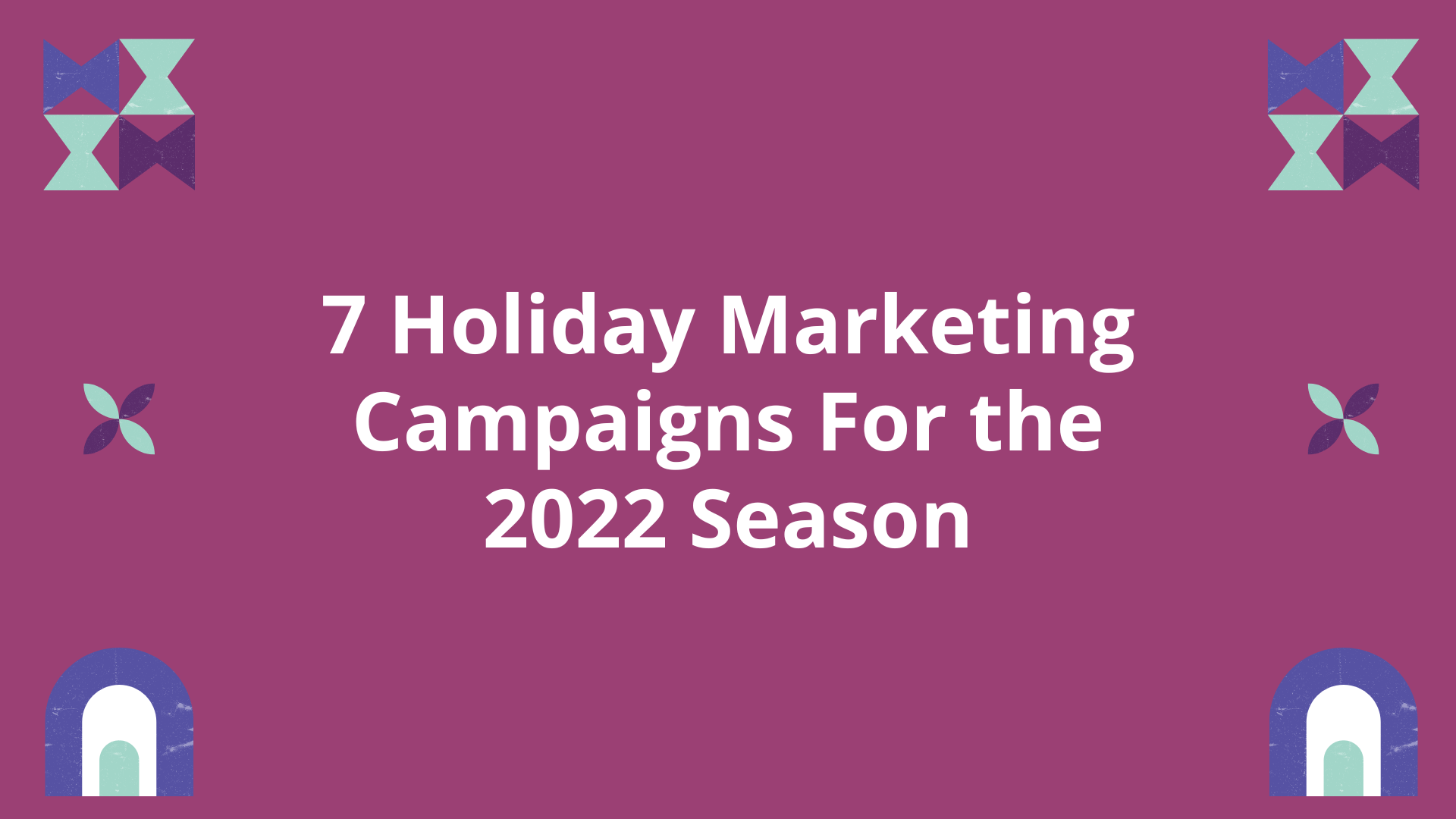
This post was written by our Account Manger Alicia Kurz.
‘Tis the season for holiday marketing campaigns. Sometime between Halloween and the first snowfall, businesses start rushing to capitalize on the spending frenzy that is the holiday season.
Consumers see holiday-themed social media posts, targeted ads, email marketing campaigns, billboards, tv ads, and the list goes on. It’s a lot to take in, but we’ve compiled a list of the most effective campaigns of holidays past and present to give you a little inspiration for your next campaign.
These brands have created campaigns that spread holiday cheer by evoking emotion and promoting sharing. Follow their lead to stand out from the white noise and make your brand stand out.
Google: Home Alone, Again
This ad will leave any Home Alone fans beaming. Thank you, Google for making us feel young again — even if it was just for a minute.
Why it’s effective
Nostalgia is a hell of a drug. It’s easier to appeal to a large target audience when you have a big budget to hire a celebrity, but anyone can use nostalgia to help amp up their holiday marketing campaign. What makes your audience feel good inside?
Coca-Cola Canada: Give Something Only You Can Give
When you see the Coca-Cola commercial around the holidays, you know it’s going to be good. Coke and Santa have been tied together since the 1920s, and their company even helped shape the image of Santa in the 1930s, so it makes sense for Coke to continue this tradition. While Coke definitely isn’t the drink we reach for around the holidays, the commercials still give us the warm and fuzzies.
Why it’s effective
The meaning of the holidays is to spend time with friends and family, not buy expensive gifts. Coke has become so tied to the Christmas season with Santa and those caffeine-guzzling polar bears it doesn’t even need to sell in its holiday ads anymore, making it a perfect ad.
IKEA: The Other Letter
This commercial might need a trigger warning if you are a parent. You WILL cry. IKEA Spain asked a group of kids to write two letters: one to the three kings (Santa equivalent) and one to their parents. No surprise to anyone, all the kids asked their parents for more time together. When the kids are told they can only send one letter, guess which one they choose…
Why it’s effective
Here’s another ad that doesn’t spend any time selling its product. The emotional impact this message leaves on their audience will last, likely creating more loyal customers in the future.
WestJet Christmas Miracle
Who doesn’t love a feel-good story, a little nostalgia, and happy families?
This campaign ran 8-years ago, but it still hits home. The WestJet team took on a sneaky project to perform 12,000 mini miracles during the holiday season. Their goal was to bring joy to over 13,000 people with the help of Santa and the WestJet staff.
We’re not crying — you’re crying! No, okay we are actually crying.
Why it’s effective
This campaign encompasses the spirit of giving. It was an act of kindness, and was completely random — which gives people watching the feeling it could have happened to them. We love how they used Santa to make their lists, and showed the hard and fast work WestJet staff had to do to pull off the gift giving. Imagine shopping for, wrapping and delivering gifts in just a few hours!
Plus, the kids' reactions definitely made us tear up.
TD Bank #MakeTodayBetter
We love a generous marketing campaign. TD Bank encouraged social media users to submit an idea for a project to help the less fortunate. They contacted 24 people, gave them 24 hours and changed 24 communities.
Why it’s effective
TD timed this campaign with the holiday season and changed the perception of its brand to a company that cares about giving back to the community. Their line “it turns out there are a lot of people with great ideas,” makes people feel like they will be heard at TD.
Apple: Make Someone's Holiday
Another ad catered to parents, but is extremely relatable: you need technology to keep the peace when travelling. The ad subtly shows the kids watching movies, colouring, and taking photos on the iPad, but the commercial takes a tear-jerking turn when the girls make a gift on the iPad for their grandpa.
Why it’s effective
The common theme throughout these impactful commercials is emotion. Apple typically focuses on function and how its products make your life better. Here they went for an emotional approach with the iPad as the centre of the story and it paid off.
Nick Offerman’s Yule Log by Lagavulin
I think we’ve cried enough already, so our last example ends on a high note.
If you are going to pick anyone to sell you scotch, I bet Nick Offerman is at least in your top 3. This ad is simply Nick Offerman sitting in a chair drinking Lagavulin for 45 minutes. There is also a 10-hour version! He doesn’t say a word. It’s somehow hilarious, soothing, festive and clever.
Why it’s effective
It’s an alternative to the classic yule log special and an instant conversation starter. The Parks and Rec star famously loved Lagavulin, so it’s an instant tie to the product, and it’s a simple idea that paid off big with over 3 million views.
Maximize Your Holiday Shopping Season
2020 saw a huge shift towards e-commerce sales from the pandemic. A Google survey showed that digital shopping has been cemented with 70% of surveyed participants stating their shopping experience would involve online touchpoints. At the same time, 80% of shoppers are seeking out in-person experiences.
This means making your marketing campaigns cater to both in-store and online shoppers!
With this in mind, communication is key. Make frequently asked questions readily available on your website and social pages. Engage your audience, don’t JUST sell to them. Remind them who is running your business and why you do what you do.
If you are looking for help getting your marketing campaigns off the ground in 2023, reach out to our team of professionals to help you get started here.
10 Black Friday and Cyber Monday Strategy Ideas for Ecommerce Businesses
- by Alyson Shane
If you run an eCommerce business, you probably don't need to be reminded that Black Friday and Cyber Monday (BFCM) are two of the most important dates on your calendar.
With $158 billion in projected sales during “Cyber Week” in 2022, finding ways to stand out can seriously impact your business's bottom line.
But how can you stand out among the ads, emails, and thousands of other marketing messages competing for customers' attention? If you're not sure, check out our list of 10 Black Friday and Cyber Monday campaigns ideas:
How to Start Planning a Cyber Week eCommerce Strategy
As we head into the holiday season, here are some things to keep in mind:
Start planning at least 4-6 months in advance. This is critical! You know that these dates are coming since they occur annually, so ensuring that your landing pages are set up, your website is optimized, and your ads are organized and ready to roll is critical for success.
Expect your Facebook ad costs to go up. On average, Facebook's cost per thousand impressions (CPM) go up by 50% during this period, so adjust your advertising budget and expectations accordingly.
Actually, just expect higher ad costs overall. Advertising costs on every channel spike up around Black Friday and Cyber Monday, so anticipate this as you start to plan.
Now that we've covered the basics, let's dig into ____ strategies to help you sell more products this season:
1. Start Building Your Audiences in Advance
"Retargeting" refers to the process of showing relevant ads to people who have visited pages on your site or who have taken an action like adding something to their cart, have saved an item to their wishlists, etc.
To build this audience in advance, run Facebook ads using the "Conversion" objective. This will cause Facebook to show ads to people who are likely to buy as a result of seeing ads, or at the very least, get them to your site so you can retarget them later.
This way, you already have an audience of recent website visitors who you can retarget when BFCM comes around.
2. Beef Up Your Retargeting Campaigns
Almost half of BFCM purchases come from repeat buyers, which is why retargeting is such an essential part of any holiday ad campaign.
During the week leading up to Black Friday, run a retargeting campaign highlighting all the deep discounts and sweet deals you're offering. Since these customers are already familiar with your brand, they're more likely to convert.
3. Promote "Early Access" Black Friday Deals
We've said it before, but we'll repeat it: email marketing is one of the most important elements of any eCommerce strategy.
However, with 116.5 million emails sent out on Black Friday, even the most click-worthy subject lines might not be enough to help you stand out in customers' inboxes.
We suggest sending your BFCM emails a week early to avoid the onslaught. Start emailing exclusive offers and discount codes to your most engaged subscribers in advance.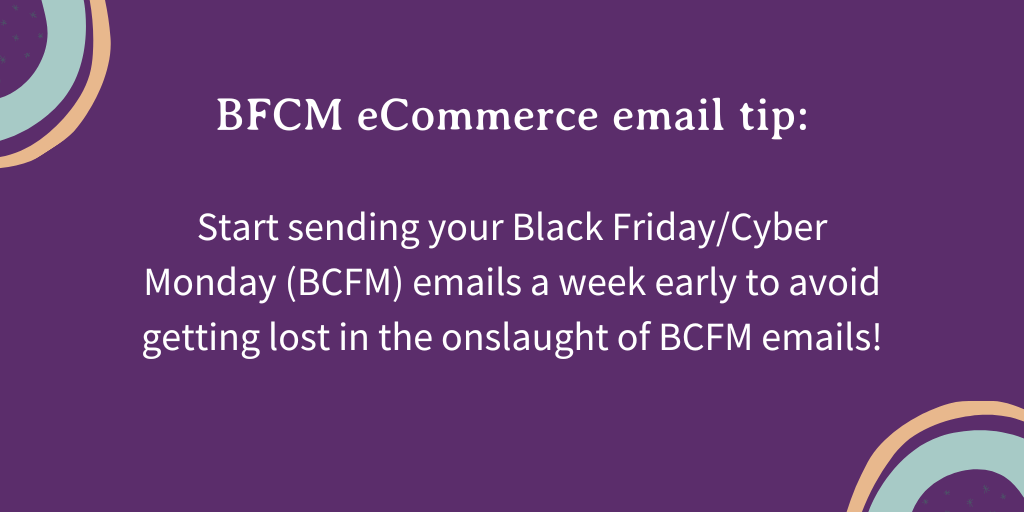
4. Segment Your Email List
Sender, beware: while email marketing can be super effective, it's also bad to spam your subscribers and cause people to unsubscribe or mark your emails as "spam."
Instead of blasting everyone on your list during the lead-up to BFCM, we suggest segmenting your list and breaking it up so you can send personalized, targeted emails your subscribers are excited to receive.
This way, you can avoid sending multiple emails to the same people in a single day and highlight the deals and offers that are most relevant to the person opening the email.
5. Double Down on High-Activity Days
Okay, this might sound like we're contradicting ourselves but hear us out: even though generally we want to avoid sending more than one email a day, on holidays like Thanksgiving, Black Friday, and Cyber Monday, a single email is going to get lost in the shuffle.
Instead of hoping that people slick on your single send, we suggest this approach:
- Send one email in the early morning, so your customer wakes up to a deal
- Send a second email in the middle of the day highlighting different deals
- Send a third email in the late afternoon/early evening with a call-to-action (CTA) that time's running out
It's essential to use different subject lines, emojis, and CTAs in all of these emails, so people don't feel like they're getting bombarded with the same messages all day.
6. Highlight BFCM Across All Your Channels
In the lead-up to BFCM, all your marketing should highlight the deals you'll be offering.
Promote them across your Facebook and Instagram ads, pay-per-click (PPC) campaigns, emails, and social media posts.
When creating content for these campaigns, ensure that your offers are consistent across all your feeds, so customers know what to expect.
7. Double-Check Your Site Speed
One of the biggest reasons people "bounce" away from a site is because it loads too slowly. Just a one-second delay will reduce conversions by 4.42% for each second.
That's why we recommend using a free tool like Google's PageSpeed Insights Tool to help you identify areas that need improving before the glut of holiday traffic hits your site.
8. Remove Unnecessary Plugins and Javascript
This is a bit in the weeds, but hear us out: leaving unused or unnecessary plugins or javascript on your site can slow it down, so work with your web developers to audit your site in the months leading up to BFCM to make sure any unused software has been removed.
9. Audit Your Product Pages
The weeks leading up to BFCM are the perfect time to give your product pages a facelift and ensure they're as enticing as possible.
Some things to look for are:
- Are all the images high-resolution?
- Do they show the product(s) being used in various settings?
- Do they showcase all available colours or styles?
- Are the product descriptions clear and SEO-optimized?
- Is the CTA clear and engaging?
10. Use Google's Address Auto-Filler at Checkout
This is one of our favourite tips to help move customers through the conversion funnel as fast as possible!
This plugin automates adding someone's address to the checkout page, saving them time and reducing the likelihood of opting out of the purchase before finishing.

Get Ready for BCFM 2022
Black Friday and Cyber Monday are coming soon, so start preparing as soon as possible, so your eCommerce business doesn't miss out on this essential time for sales and conversions.
If you didn't start building your audiences months ago, it's okay — there are still several steps listed above that you can do between now and then.
If you need help creating a BFCM campaign strategy custom-tailored to your eCommerce business, the team at Starling Social is here to help.
You can also stay in the know with the latest digital marketing strategies by subscribing to our weekly digital marketing newsletter!
How to Write Newsletters People Want to Read
- by Alyson Shane
This post was guest written by Rose Regier.
If you’ve been around here for a while, you already know that “We’ll just post on Instagram” isn’t a marketing strategy.
If you’re new to these parts and you beg to differ, let us bring you up to speed:
While social media probably should be a huge part of your marketing mix, it’s not everything. Social media is like playing to a crowd at a music festival where hula hoops, kettle corn, and hand-made jewelry are competing with you for your audience’s attention.
Email marketing, on the other hand, is like inviting someone from that crowd to your house to jam.
Now you have them on your front porch, ready to hear the acoustic versions of your songs, and they’ll probably stay and chat after. And there’s the beauty of email - it’s consent-based, it’s personal, and it’s free!
Signing Up for The Goods
Before we talk about the newsletter, let’s talk about the opt-in process.
It’s a good idea to have a marketing strategy for promoting your newsletter. Use your social platforms to tell people why they should sign up, and make it easy for them to do so by linking to an opt-in page and featuring your sign-up box prominently on your website.
Consider giving something away for free when people sign up - this could be a product discount or a free guide to get them interested in your offerings.
This may not be right for everyone though, depending on your business. A lot of people sign up for emails just to get the freebie and then unsubscribe once they get it.
The Welcome Email
Once they’ve signed up, you have one golden opportunity to start the relationship off on the right foot - the welcome email. Welcome emails have 4x the open rate and 10x the clicks as any other type of email.
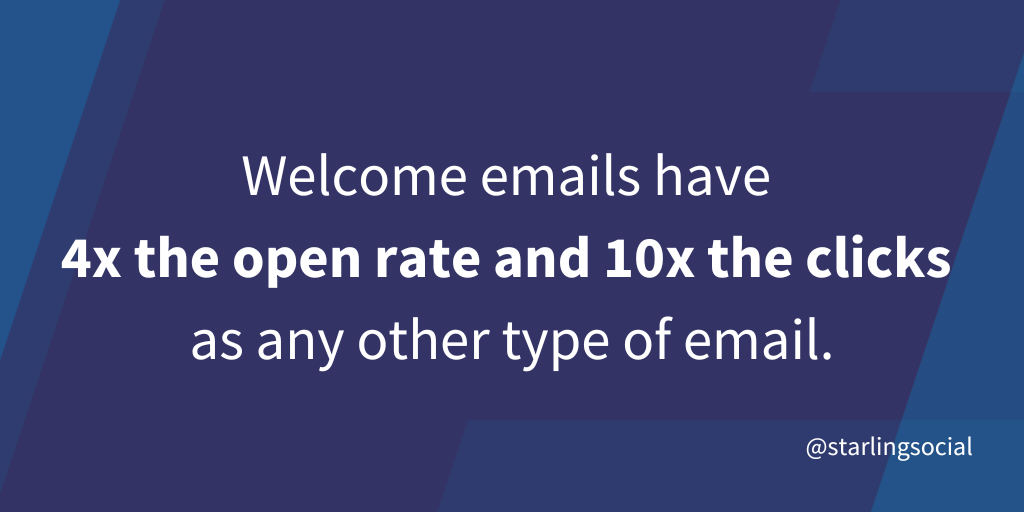
Here’s where you deliver your freebie or a discount code if you’re doing that, and also where you set expectations by letting folks know how often they’ll hear from you and what type of content they can expect. Once you’ve told them what to expect, you’d better follow through. Consistency is an important part of building trust with your potential customers.
The Subject Line
What makes people want to open an email in their inbox? Take a look through your own inbox and make note of which promotional emails you’ve opened recently and consider why.
Subject lines personalized to your customers’ interests are the most likely be opened. In fact, this matters more than discounts or time sensitive offers.
Every email you send deserves a unique subject line. “Weekly email” or “Newsletter #27” won’t cut it. Let folks know what’s in this specific email and why they should read it.
Subject lines should be short (less than 10 words), use emojis if appropriate, and contain a hook that gets people curious. Verbs are your friends! Consider using your customer’s name in the subject line to take your personalization up a notch.
Make sure what you’re promising in your subject line is delivered in the email.
Here are some subject lines we love:
- Rock the colour of the year (Etsy)
- Must-have tees from $15 (Everlane)
- How to live at home 24/7 (Feather)
- Where to drink beer right now (Eater Boston)
- 3 rules for marketing during a crisis (Digital Marketer)
The Pre-Header
An email pre-header is the text that follows your subject line, and it’s another opportunity to create interest in opening your email.
Your subject line and pre-header should work together to capture your customers’ curiosity.
Different email providers have different limits on the number of characters, so keep it short and snappy - somewhere between 30 and 80 characters. You can use this space to ask a question, offer an incentive, include a call to action, or to summarize your email.
The Goods
Let’s get into the content of your newsletter. What you write depends on your business and what your customers find valuable. Remember to think about what’s in it for your customer when they open your newsletter. Be energetic in your copy, and use humour if appropriate.
Your newsletter could focus on industry news, products, company updates, testimonials, or blog posts. You can include a mix of all of these, but choose one type of content as your feature.
Start somewhere, and then measure. After a few months, the data will tell you what content is working and what you can ditch.
If you have more than one type of customer, segmenting your email list and sending more personalized content is a good idea.
The Best Time to Send
Recognizing the sender and having time to open an email are the two biggest factors that affect whether people will open your email or not. Given that they’ve subscribed, you can check off the first one.
Figuring out the best day and time to send your email newsletter will require some testing, but some recommendations on a starting place are to send your email:
- On weekdays - Tuesday, Wednesday, or Thursday tend to perform better than Mondays and Fridays
- During the day - test a few different times of day to find out what works best for your audience
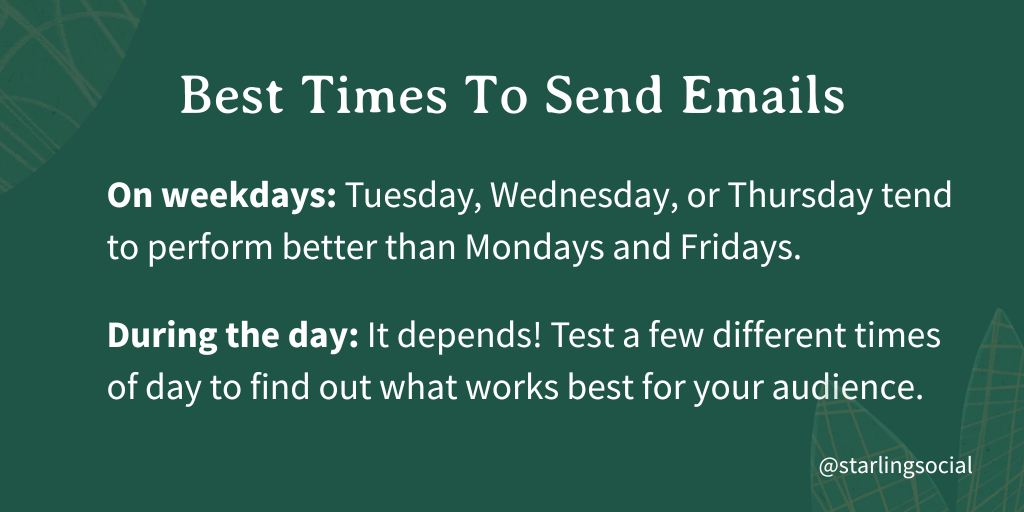
The Format
The average time spent looking at an email newsletter is 10 seconds, so make it easy to skim by using white space and separating copy into bite-sized chunks. Put the most important information at the top, and use descriptive headers to separate content sections.
Remember that more than half of your subscribers are likely opening your email on their mobile device, so keep this in mind when you’re designing your newsletter. Send test emails and open them on your desktop and phone to make sure the format works for both.
Length
Aim for an average of 20 lines of text, or around 200 words. Any longer than that and you’re probably wasting time on content that won’t get read.
Images
Including images makes your newsletter more visually appealing, but remember that images can also slow down load time which can hurt your open rates.
Start with high resolution images and scale them down to keep them crisp. Optimal image size will depend a bit on which program you use to draft your newsletter. In general, keep file sizes less than 1 mb. Image types can be PNG, GIF, or JPEG. Header images should be 600 pixels wide.
Be sure to include alt text with your image for accessibility.
If you need more help writing newsletters that your customers want to read, we’ve got you!
What's an Entity First SEO Strategy and How to Build One?
- by Alyson Shane
“Entity search” “might just be one of the most important SEO tactics you’ve never heard of!
This (somewhat) obscure term has become something we’ve been focusing on here at Starling Social since Google updated its topics application program interface (API) back in June of this year.
This update to Google’s most comprehensive and powerful deep learning algorithms means that marketers and businesses need to be thinking more deeply about semantic search than ever before.
If you’re new to terms like “semantic search” and “entity SEO” don’t worry! Today we’re going to dig into what these two terms mean, and how you can leverage them to help customers find your business.
What’s Semantic Search?
Semantic search describes a search engine’s efforts to generate the most accurate results on the search engine results page (SERP) by using algorithms to understand search intent, query context, and the relationship between the words being used.
Or to put it another way: semantic search is a search engine’s attempts to understand natural language the way a person would.
What is Entity Search?
Back in the day, a search was performed almost exclusively by typing words (keywords) into a search engine, but now 40 - 50% of all searches are conversational, meaning that they’re done through smartphones, Alexa, Google Home, etc.
This change is why search engines have put so much energy into understanding the context and intent behind a search query. As a result, search has evolved from keywords, to “entities”.
“Entities” are expressions that a search engine can understand without ambiguity, regardless of the language being used. This can include:
- A person’s name
- A numerical expression
- A place
- An object
- An event
- A concept
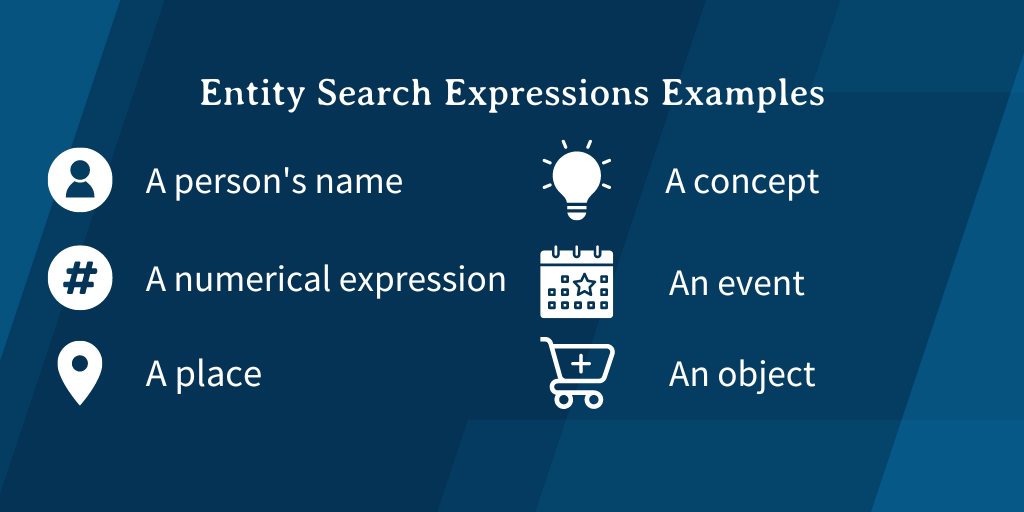
Let’s look at an example: the search query “what’s the cheapest price for an AirBnB in Toronto?”
Here’s how a search engine would understand the query:
- What: A concept (question qualifier)
- Cheapest: A numerical expression (lowest cost)
- Price: Numerical expression
- AirBnB: Organization
- Toronto: Location
By connecting these entities, search engines can understand both the search query, as well as the intent behind it.
Once these areas are understood, a search engine will try to find the most relevant information about the “entities” in the query by scanning content on the web and using AI to sort and present it to the user. This is called “entity/semantic search”.
The Difference Between Entity SEO and Traditional SEO
In traditional SEO, web pages are ranked on “scores” based on relevance, authority, and the number of backlinks from other websites.
Entity SEO focuses on showing the most useful information based on entities, facts associated with those entities and questions related to them.
What
The topic of the search query and what a user expects to find when they search for that topic. This sounds similar to traditional SEO and keywords, but semantic search takes a different approach.
Let’s think back to the example above: how many ways could someone ask the same question? Would it be asked differently in other languages?
Making sure your content is as comprehensive as possible and offers credible information about the topic, and covering as many related topics as possible, is how you can optimize your content for entity SEO.
Why
This describes the intent behind the search. What is the person looking to find out?
Are they considering and comparing options?
Are they looking for directions?
To make a decision?
To complete a transaction?
Using a combination of “what” and “why” will allow you to create content that’s SEO friendly and caters to your customers at every stage of their buying journey, so creating content around these topics and interconnecting them can help your page show up on a SERP more often.
How
Nowadays, how a search was performed is almost as important as what’s being searched for, so consider how your audience might want to consume the information they’re hoping to find.
Video, images, bulleted lists, hours of operation, FAQs and question and answer sections, and more are all excellent ways to create entity SEO-friendly content for your site.
The Four Outcomes Your Content Should Accomplish
The five outcomes you want to accomplish are:
1. Discoverability. Make sure your content is “discoverable” by search engines and by customers at different stages of their buyer’s journey.
2. Relevancy. Your content needs to meet your searcher’s needs and have as much info as possible.
3. User-friendly. Your content needs to be easy to read and understand.
4. Engaging. Engaging content encourages readers to take the desired goal (learn something, sign up, fill out a form, etc.)
Creating content that’s relevant, topical, and increases “discoverability” means keeping these elements in mind:
- The content should be personalized. Readers should feel like it was written for them, specifically.
- The content must tell a story. It needs to be engaging and capture readers’ attention.
- The content should be scannable. It needs to include headers, sub-headers, and elements like bulleted lists to make skimming easier.
- It must include images. These both break up the text, make things clearer, and offer more SEO optimization opportunities.
- The content must be mobile-friendly. According to Statista, 55.79% of all web traffic in Q1 2022 came from mobile devices, so make sure your content is readable on smaller screens.
How to Align Your Content With Entity First SEO
Before we talk about how to align your content, let’s take a quick look at how search engine priorities, algorithms, needs, and results have changed over time:
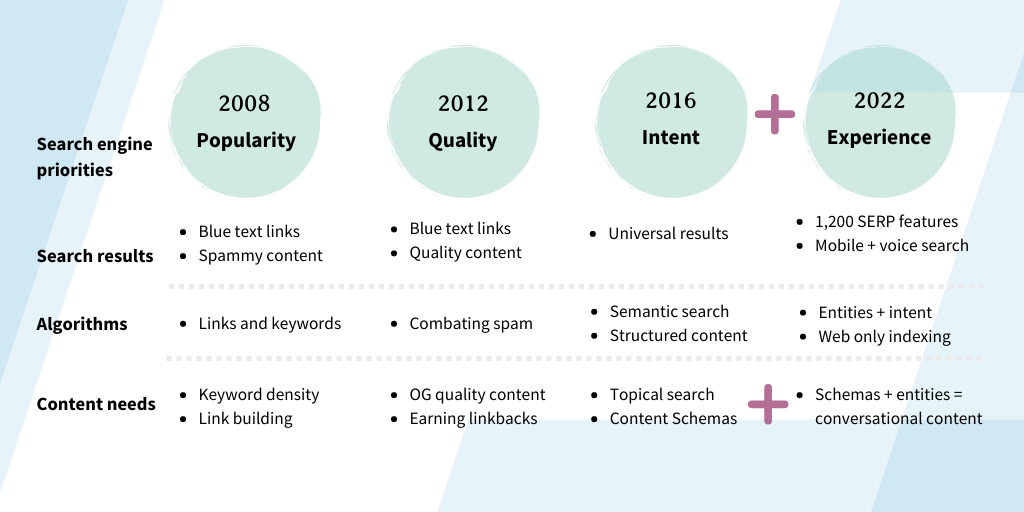
Like we said before: the way people are searching is changing, and the shift to searches performed through “screenless” devices means that the AI powering search engines is trying to replicate how humans think and speak.
If you’re wondering how you can tailor your SEO strategy to match how search engines have evolved, here’s how:
Consider Your Website Schema
This is a bit wonky, so stay with us: schema markup (also known as structured data) is the language of search engines. It was introduced by Google in 2011 as a way of helping search engines display more relevant results to users.
Web schemas are basically words or “shared vocabulary” that help refine searches and display more relevant results to the user.
Here’s an example: you and your friends want to go camping in Red Deer, Alberta… but when you try to perform a search, a bunch of results for red deer the animal come up. This is because Google didn't have context to understand that you wanted information on the city, not the animal.
So when you’re considering the content to write and the metadata to add to various pages on your site, make sure to consider the schema vocabulary to include, and the most relevant pages to include it on.
Consider the Market Opportunity for your Keywords
Use an in-depth keyword research tool (our fav is SEMRush) and do research into how different keywords in your industry are performing.
Then, map your content based on three factors:
1. Informational
2. Navigational
3. Transactional
Here’s an example of what that could look like:
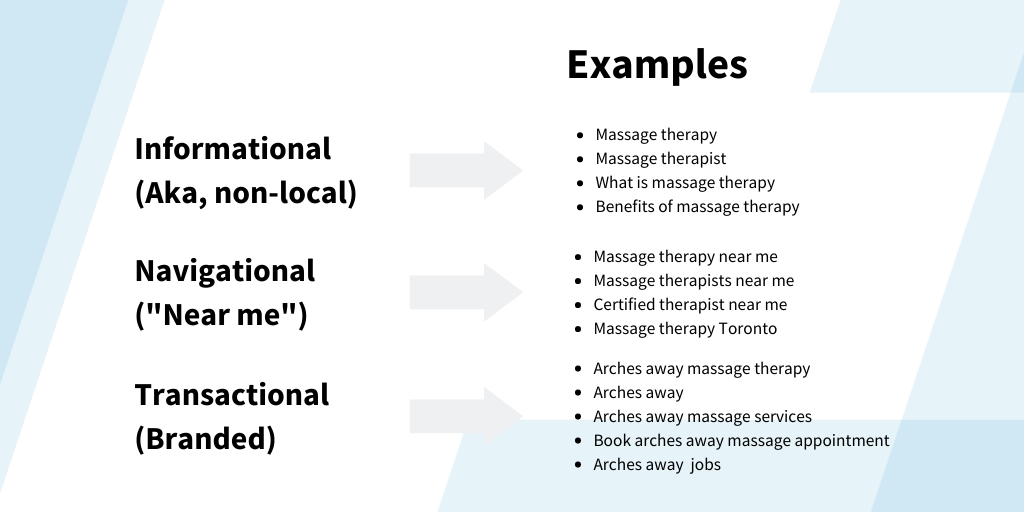
Identify Topic Gaps
Once you’ve identified your high-priority keywords and the best pages to use them on, cross-reference those findings against topics and entities covered by other high-ranking websites.
Some things to cross-reference against your own site include:
- Image alt tags (here’s two easy ways to check)
- Headings
- Lists
- Metadata (here’s how to do that)
Update Your Web Pages
Once you’ve identified what other high-ranking sites are doing, it’s time to compare against the pages on your own site and start identifying the areas where you can start adding in more content and schema-focused keywords.
Some areas you’ll want to focus on updating and optimizing include:
- Meta Keywords Attribute. A series of keywords you deem relevant to the page in question.
- Title Tag. This is the text you’ll see in the SERP and at the top of your browser. Search engines view this text as the “title” of your page.
- Meta Description Attribute. A brief description of the page.
- Meta Robots Attribute. An indication to search engine crawlers (robots or “bots”) as to what they should do with the page.
More info on these topics can be found in this handy article from WordStream.
Protip: if your site is hosted on WordPress, the Yoast SEO tool is a great plugin that can help you optimize all these elements!
Optimize Your SEO for Entity Search: Recap
SEO is more about just the content on your page (though that’s important, too) — you need to consider the page layouts, how they link to one another, design elements, entity coverage, and schema.
To make this easier for yourself, think about the main pages on your site as “spokes” in a wheel, the other relevant pages that link back to it as the “spokes” in that wheel.
To recap, if you want to optimize your site for entity first SEO, take these steps:
- Consider your website schema
- Do research on your target keywords
- Identify topics on other high-ranking sites
- Identify content gaps between those sites and your own
- Update your pages with content, headers, metadata, etc.
Staying up-to-date with the latest SEO trends is easy! Just subscribe to our weekly digital marketing newsletter for the latest articles, resources, and insights.
Our Top 7 Favourite Content Marketing Tools
- by Alyson Shane
We first read about the three-legged stool metaphor in Arianna Huffington’s book Thrive. In her metaphor, the three legs of the stool—money, power, and well-being—are the pillars of success, and eliminating any one of them causes your stool to topple over.
We think this metaphor works well for content marketing too. The three legs of your content marketing stool are strategy, creativity, and process.
If you have a lot of creativity and great processes but no strategy, you’re going to create some banging content on the regular, but it’ll fail to to drive the results you’re looking for.
If you have strategy and processes down but no creativity, you’ll be efficiently pumping out some very bland and derivative content that has an objective, but doesn’t keep people interested.
And finally, if you’re creative and strategic but you can’t get your s*** together, all those great ideas will just live in your head or on a post-it somewhere without getting to the people who you’re trying to reach.
Lucky for you, you don’t have to be naturally proficient in all three areas to be successful. There are tools and resources to help you, and if you use them consistently your content marketing stool will be topple-proof.
A Note on Order of Operations
Strategic planning comes before process and creativity. Without strategy, you’re shooting your arrows into the sky. Strategy ensures you know what you’re trying to achieve, who you’re trying to reach, and how you’re going to get where you want to go.
Unfortunately there’s no magic tool that will hand over a strategy, that’s work you just have to sit down and bang through. As you’ll see though, tools come in very handy when it comes to the measurement part of your strategy.
Google “Content Marketing Tools” (Actually, Don’t)
A quick Google search will tell you there are way too many tools out there to choose from, and if you’re like us, this type of research can quickly turn into a rabbit hole of procrastination.
Let us save you some time so you can get back to business. Here’s a look at our favourite tools that we use daily at Starling Social, and which legs of the stool each supports.
1. Trello (Process)
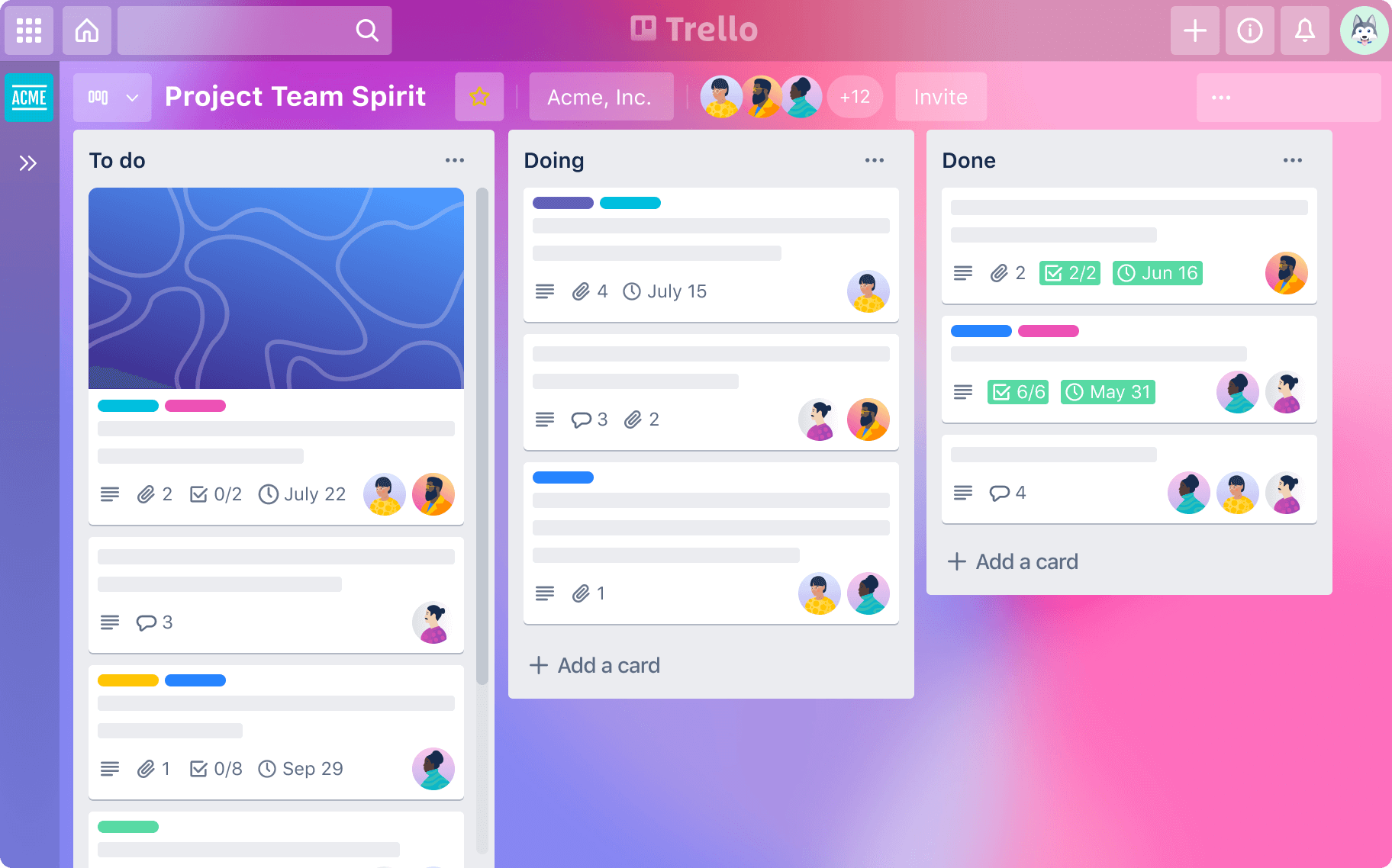
Image via Trello
Trello is the foundation of our processes. This kanban-style project management tool is visual, it’s collaborative, and it keeps us on track.
Here are some ways Trello supports our processes:
- Collaborate internally and with clients
- Assign tasks
- Add due dates
- Keep track of upcoming events
- See what’s in progress, in review, or done
- Link to templates, planning documents, spreadsheets
There are countless ways to use Trello, and a quick search will help you find templates to get you going with minimal effort. Click here to dive deeper and see exactly how we use Trello in our business.
2. Sendible (Strategy)
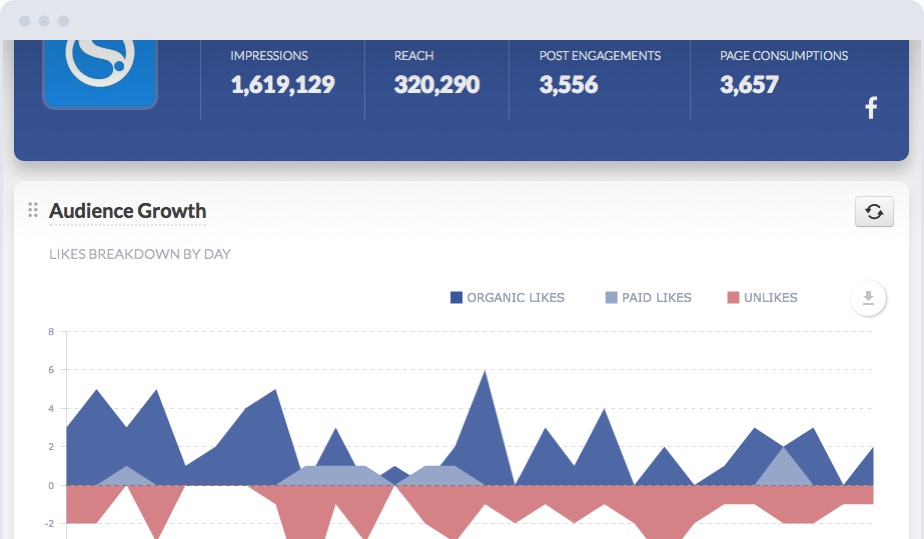
Image via Sendible
A key part of your digital marketing strategy is measurement. If you don’t take the time to measure results, you don’t know if what you’re doing is working. Measurement also tells you where to focus your efforts and allows you to refine your strategy as you go.
Going into each social platform to pull out data is mega time-consuming, so having a tool that collects all that data in one place is key. We use Sendible to collect and analyze data for our clients so we can create handwritten reports with recommendations every month.
Here’s why we like it:
- It not only presents data, it gives insights that are actually meaningful rather than just showing generic charts that don’t paint a true picture of how things are going. For example
- "Twitter was your most engaged platform last month, with a 22.4% increase"
- It's affordable. We’ve looked at many analytics tools, and this one does more for less.
- The Reports hub is clear and useful. Mentions are clearly broken down by source with the number of mentions and the corresponding percentage. You can see overall sentiment based on positive, neutral, and negative mentions. It’s a great interface for finding trends and measuring mentions against competitors.
- You can access Google Analytics within Sendible, which is very convenient for tracking how effective your social campaigns are driving traffic to your website.
3. Feedly (Creativity)
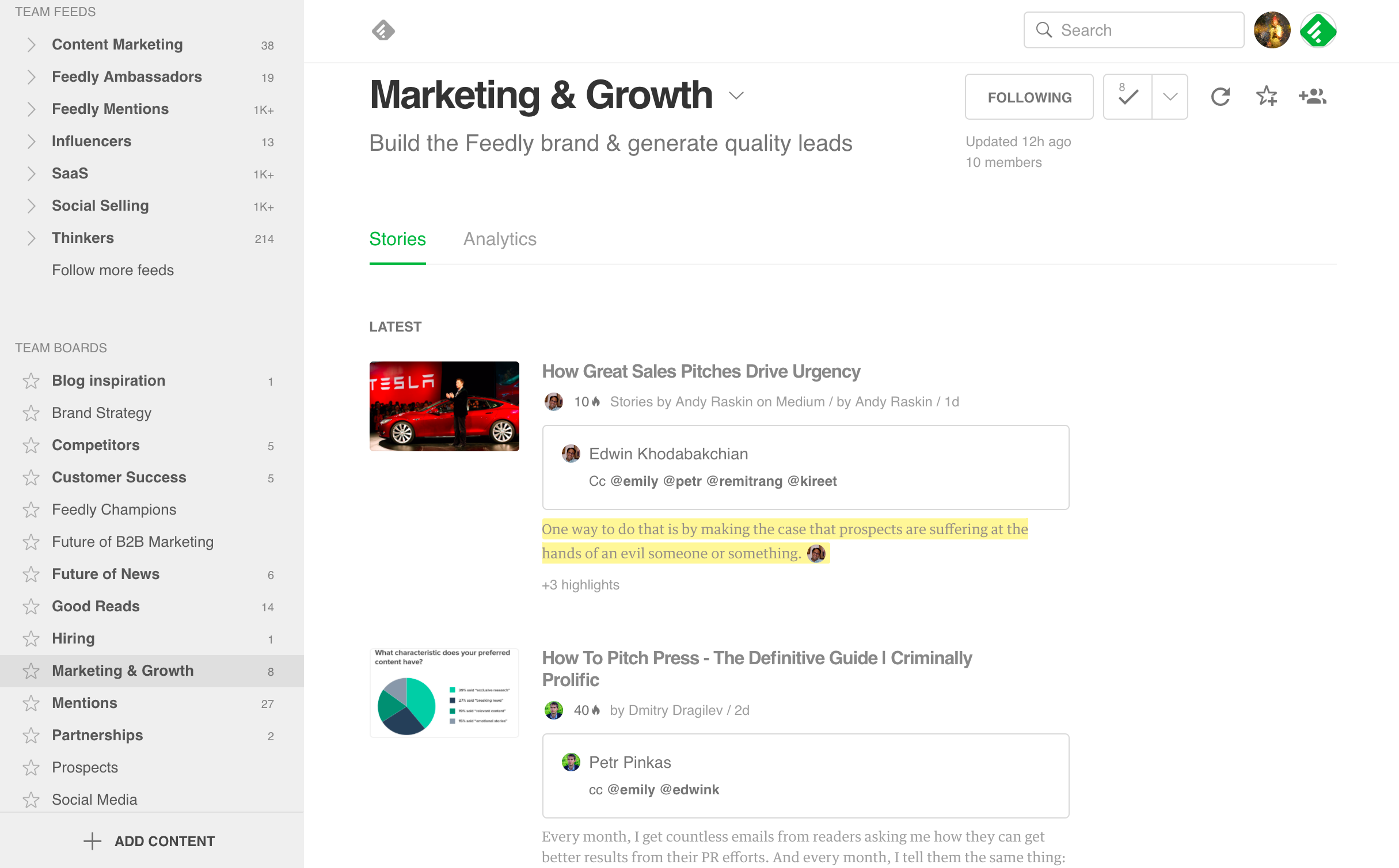
Image via Feedly
Creativity doesn’t happen in a vacuum. Even the most creative types get inspiration from others. Seeing what people are talking about as it relates to your business can inspire you, and also keeps you relevant. Seeking out news and finding inspiration can take a lot of time, and that’s where Feedly comes in.
You tell Feedly what’s important to you, and it uses AI to flag content that you might find useful. We use Feedly to track marketing trends, and to curate content for our weekly newsletter.
4. Buffer (Process)
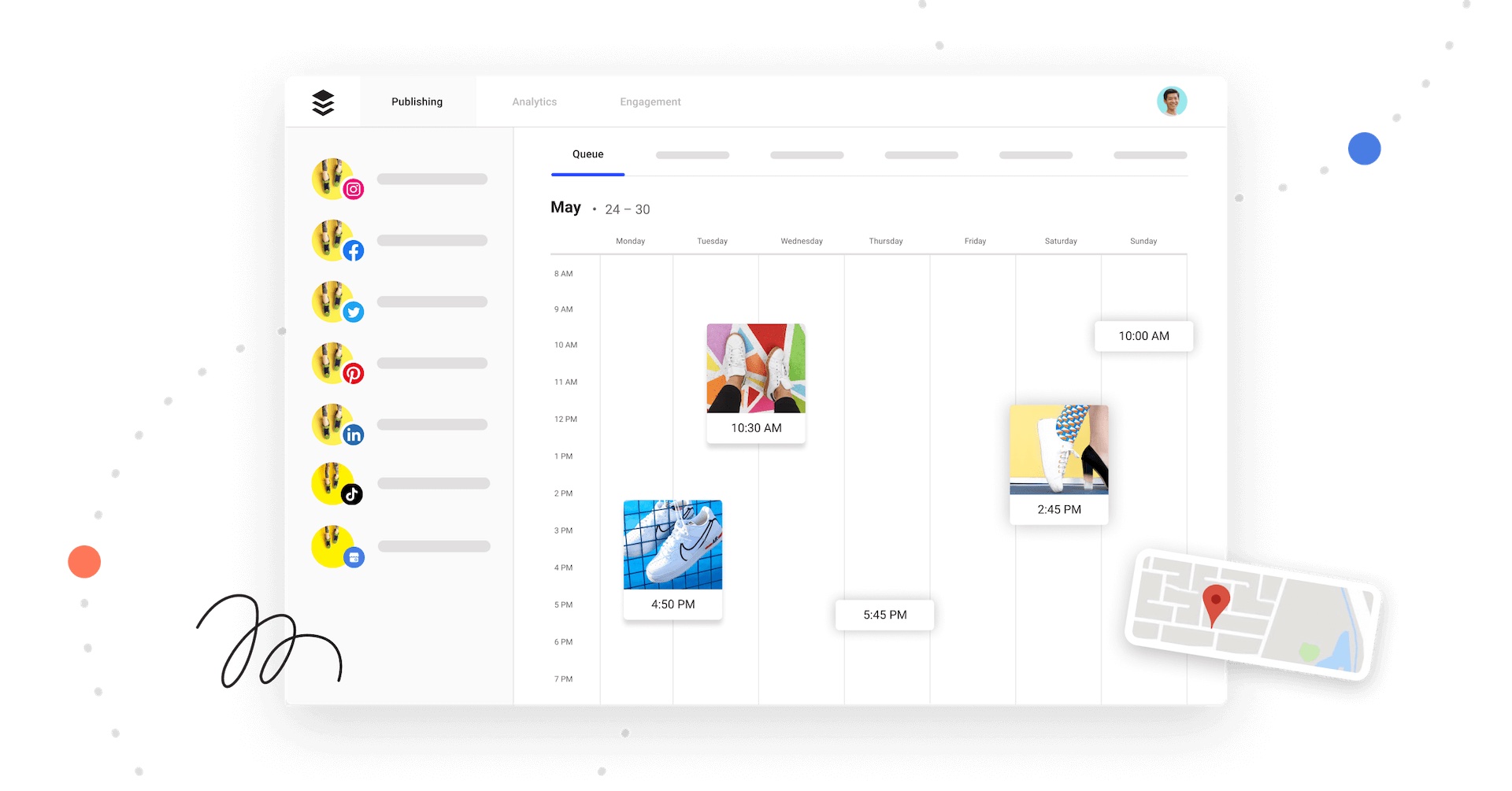
Image via Buffer
Buffer is a scheduling app that works with all major social platforms. For maximum efficiency, we recommend scheduling posts up to a month ahead of time and reviewing weekly to make sure what’s in the queue is relevant based on current events.
The dashboard is super user-friendly and the calendar function allows you to see all your planned posts at a glance to make sure there are no gaps in your posting schedule.
We find the draft posts function especially useful, because it allows other team members to jump in and review before content is officially added to the queue.
5. Google Drive (Process)
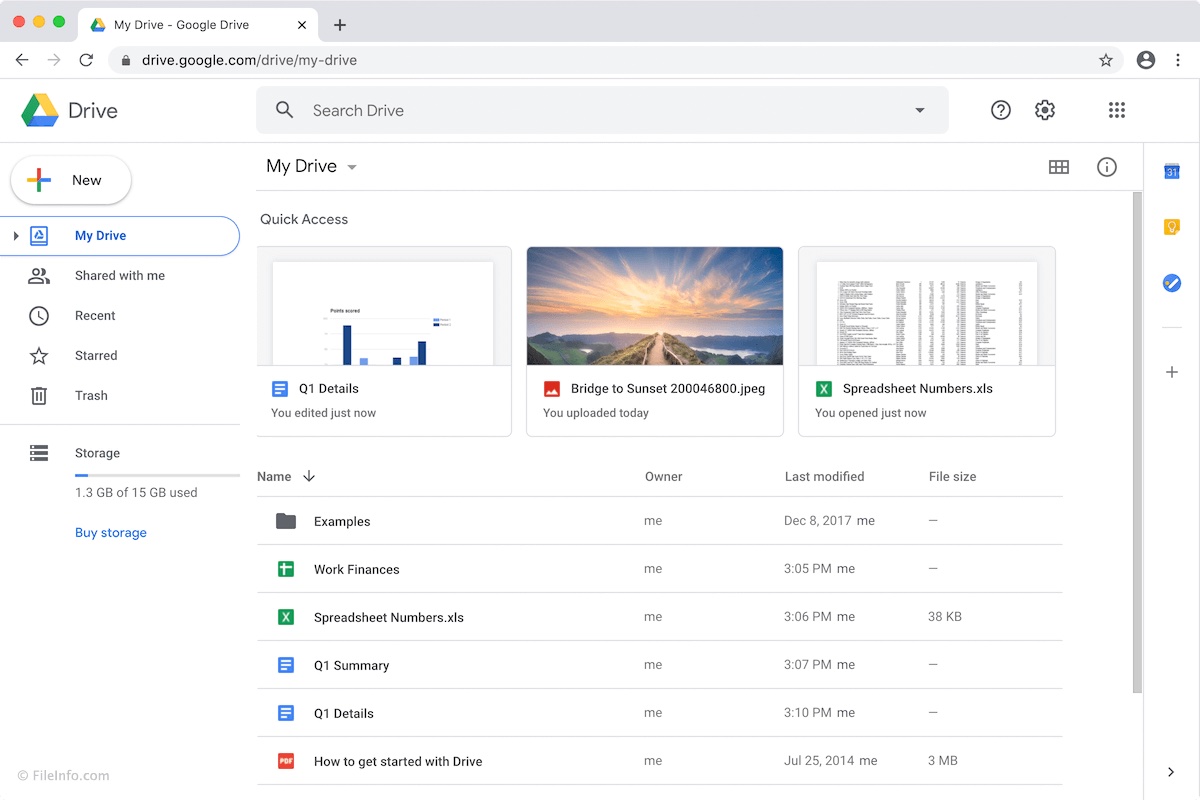
Image via FileInfo
Google Drive is our go-to for documents and spreadsheets. It’s cloud-based, so any number of people can collaborate on the same document at the same time. We use Google Docs for meeting notes, marketing plans, and for drafting blog posts and social content. Google Sheets allows us to create spreadsheets for customer personas and content calendars.
Why choose Google Drive over Microsoft OneDrive? It comes down to personal preference. They both offer real-time collaboration, offline access, and syncing across all your devices. The major difference is how you access them on a desktop computer: Google Drive is browser-based, and OneDrive is an app you download. Die-hard Microsoft Office users will likely find the familiarity of OneDrive preferable.
6. Canva (Creativity)
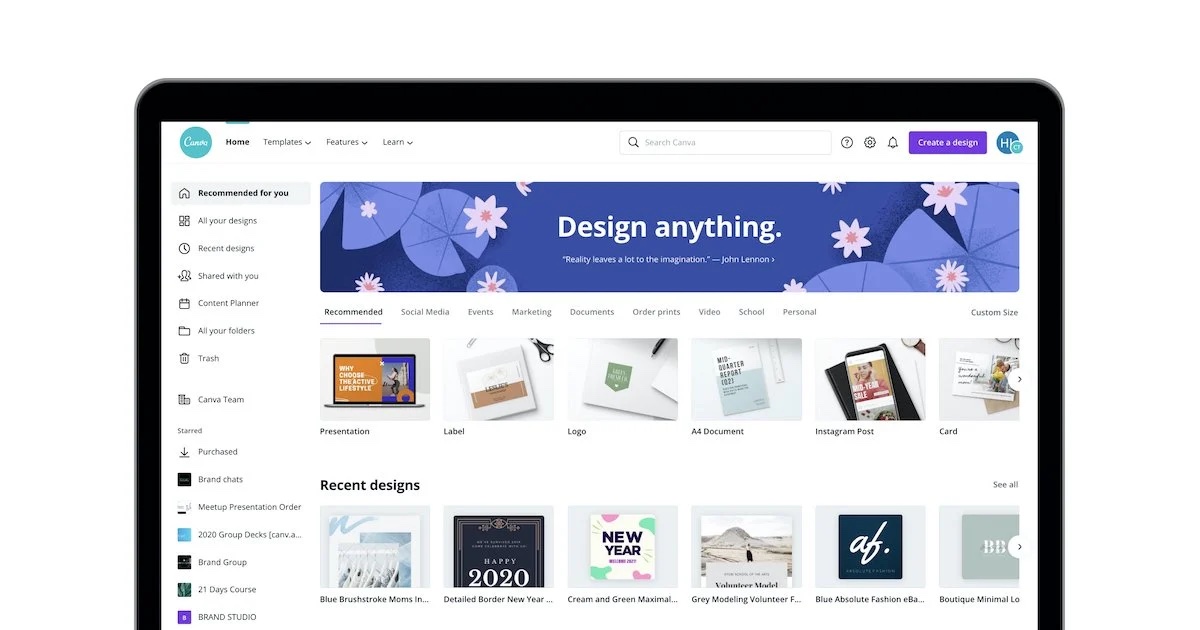
Image via Canva
Canva is a design-light tool for people who want to make eye-catching graphics but don’t have the time/desire/skills to start from scratch in a program like Adobe Illustrator.
Forget trying to find the right image size for different social platforms, because Canva has the optimal sizes pre-loaded in their templates. You can start with a blank canvas or use one of their thousands of templates to get started and then customize it.
We also use Canva to search for stock images, though this feature works best if you have a Pro account, which gives you access to 90 million stock photos.
Hot tip: you can filter your image search by colour to find photos that work with your brand colours.
7. LinkTree (Process)
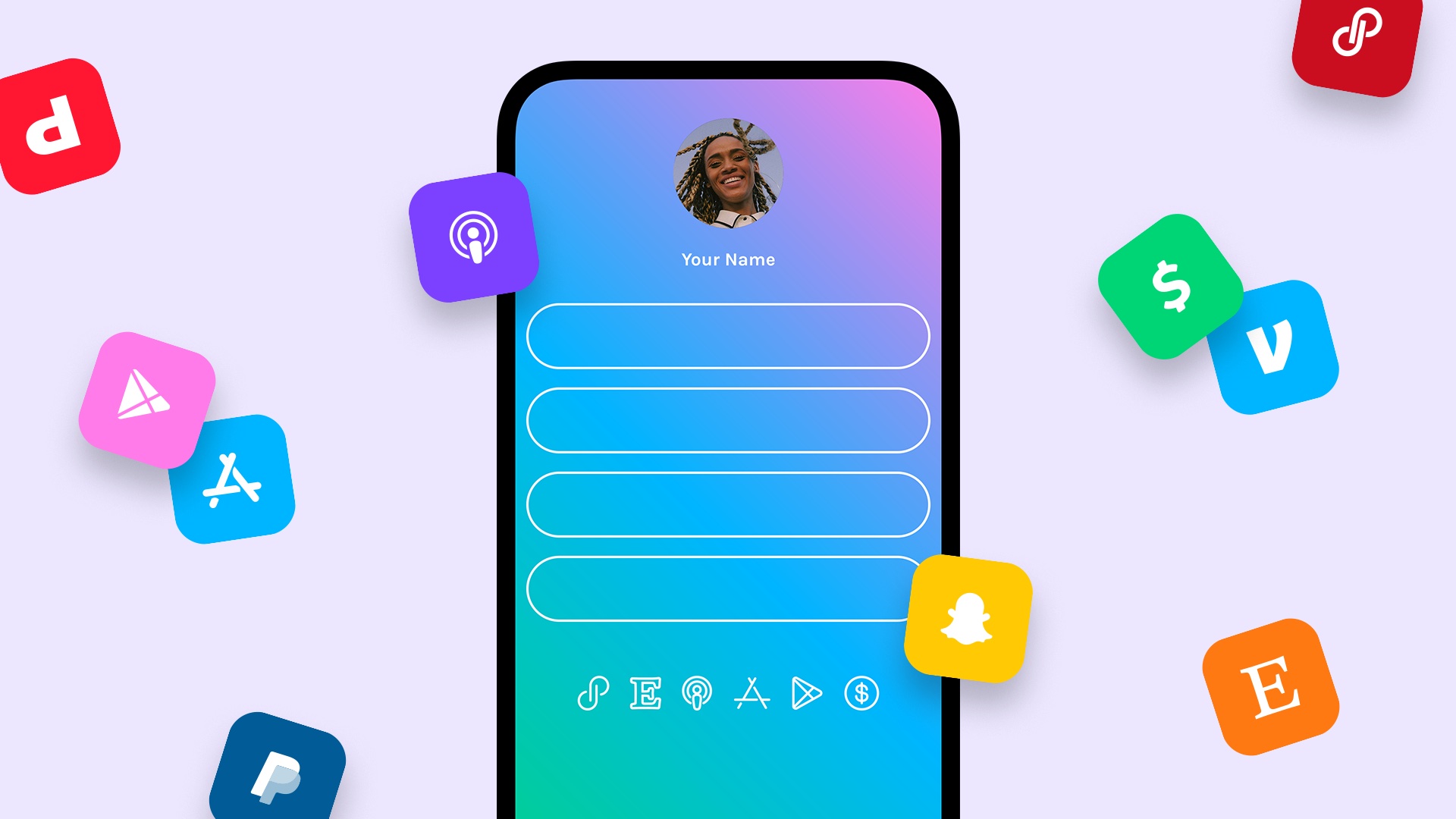
Image via LinkTree
Do you see people including links in their Instagram captions? Don’t do it! They aren’t clickable. They’re not even copy-pasteable, unless you’re scrolling on a browser, which is not how most people use Instagram.
Create a smooth user experience by directing people to your Instagram bio where you can use a linking tool like LinkTree to send people to the specific content they’re looking for.
You can customize the colours to match your brand, and unlike many other Instagram linking tools, this one is free! According to LinkTree, the optimal number of links is 3-7. Any more than that and you can overwhelm your customer.
Improve Your Content Marketing Today
There you have it folks. Happy stool-building! If you’re feeling overwhelmed, we’re here to help you get your content marketing stool into tip-top shape.

